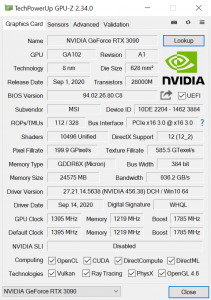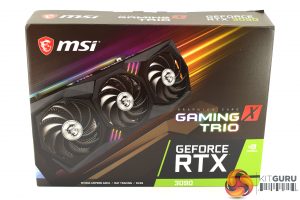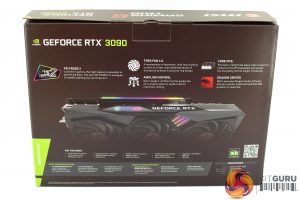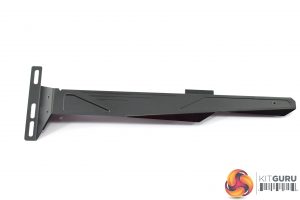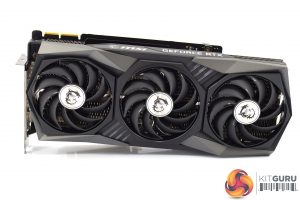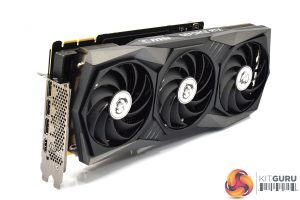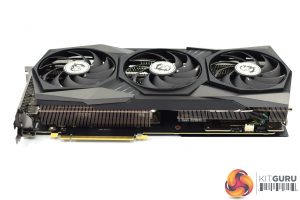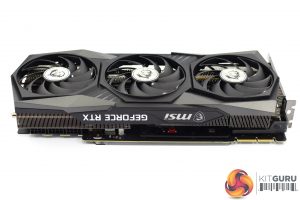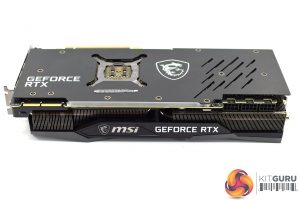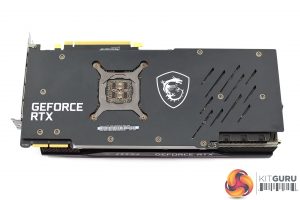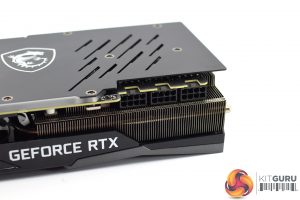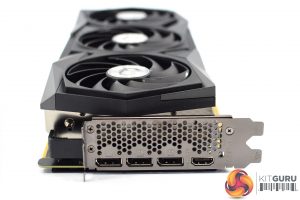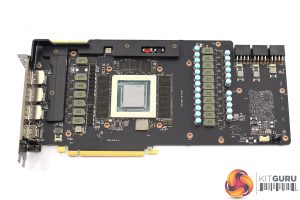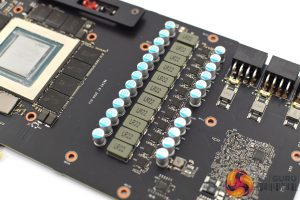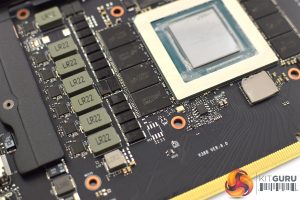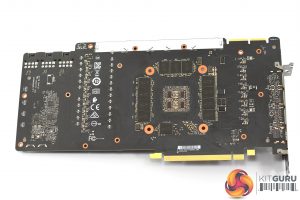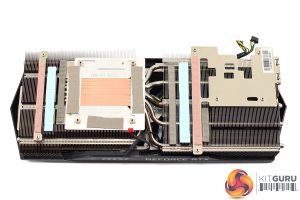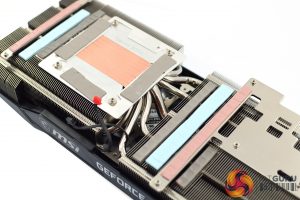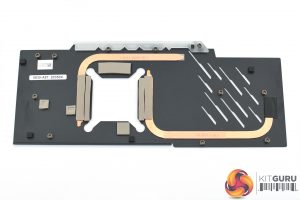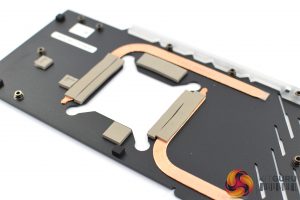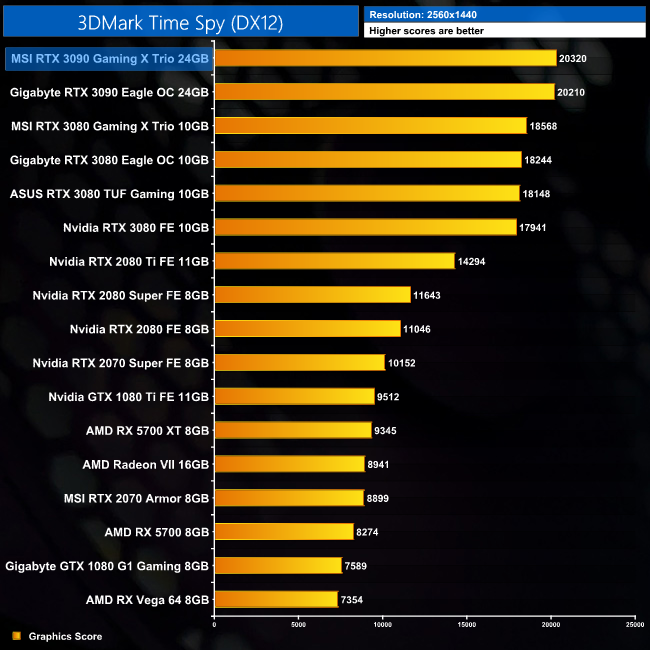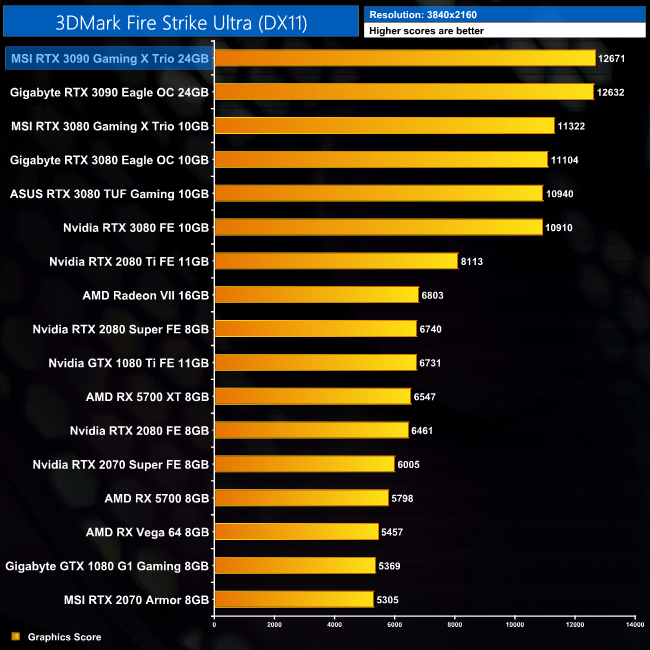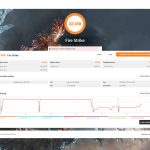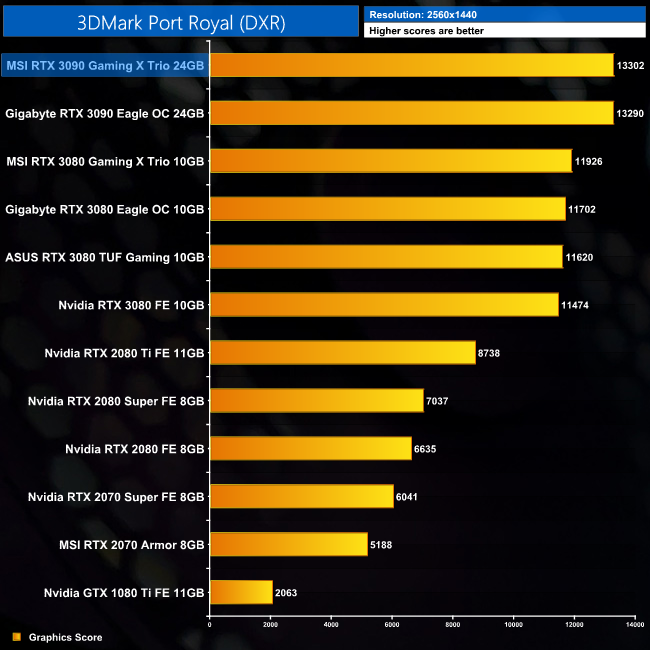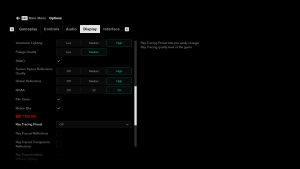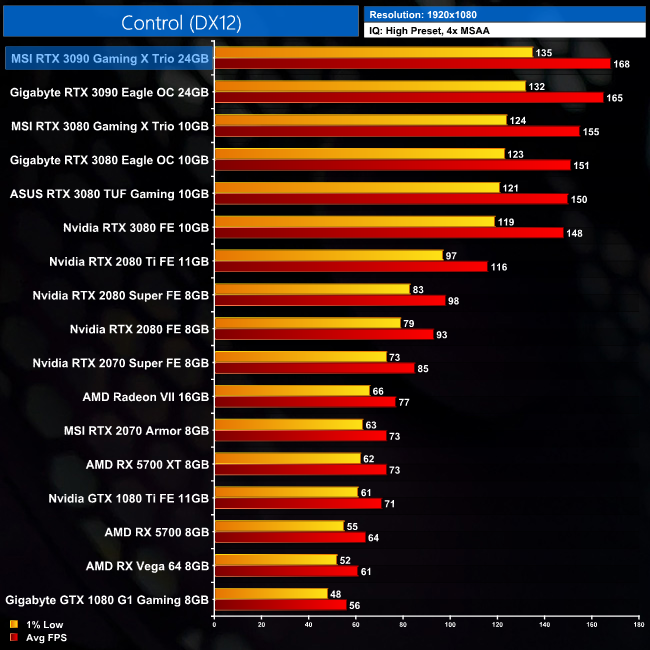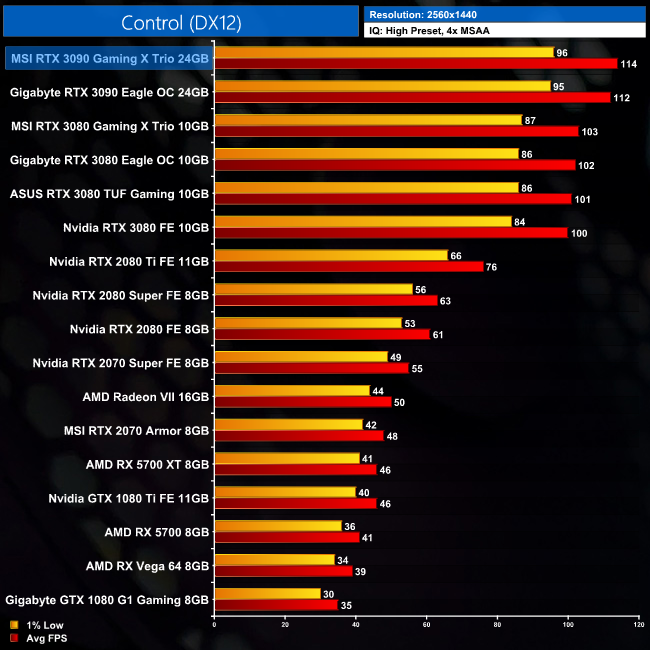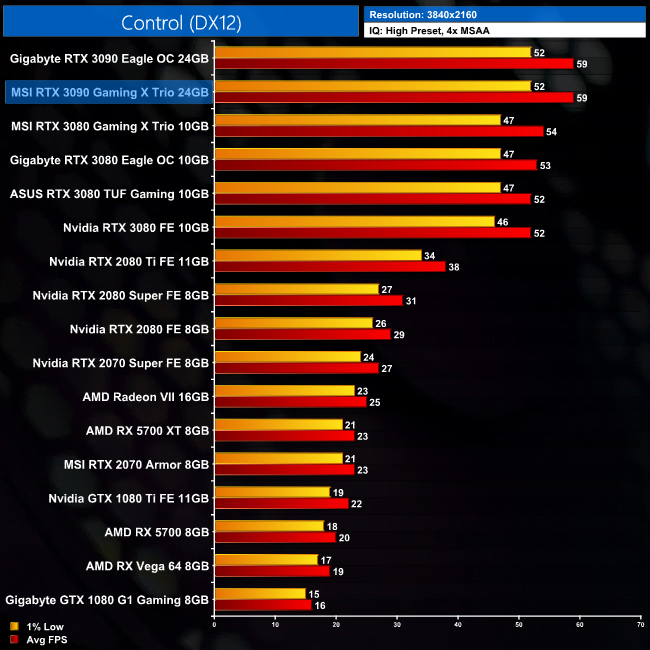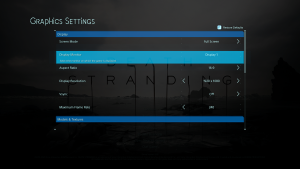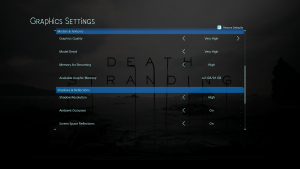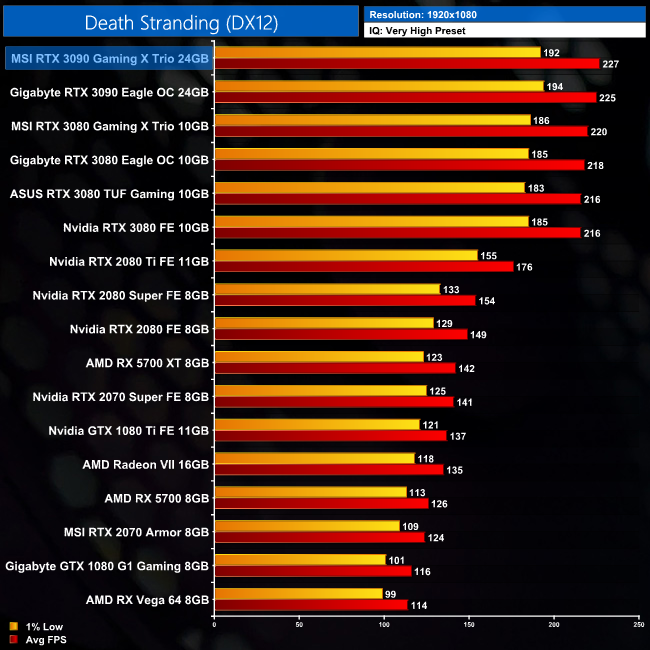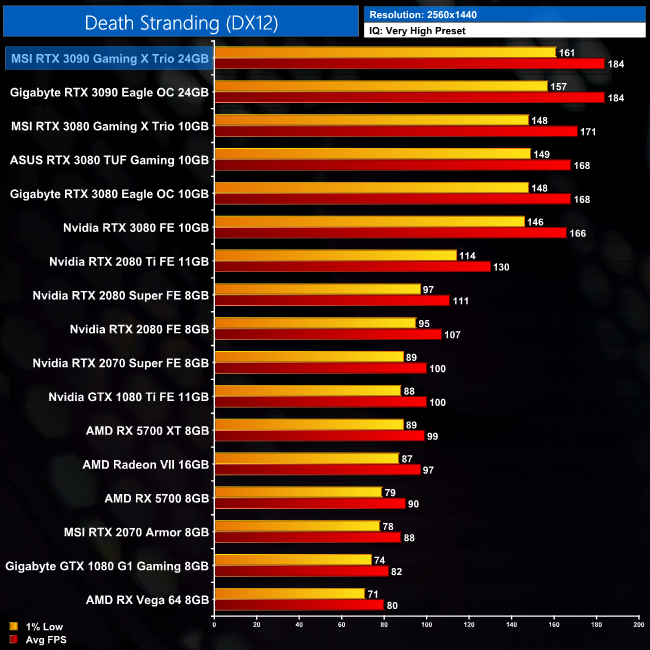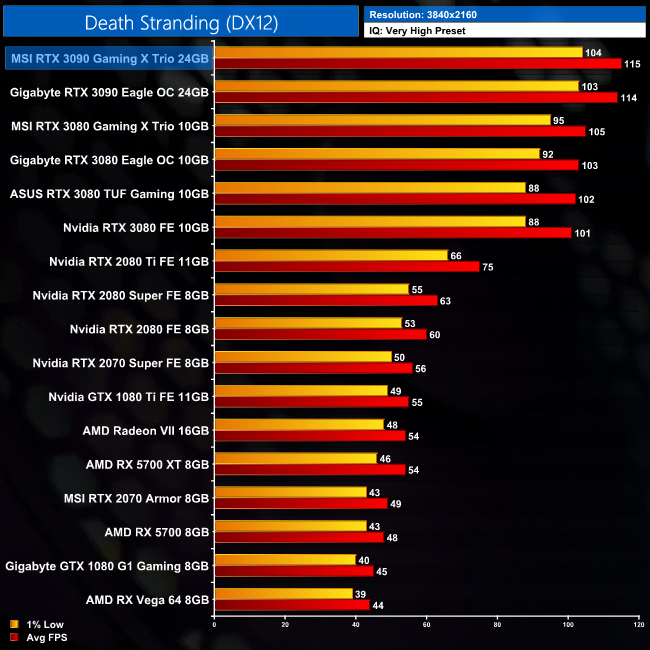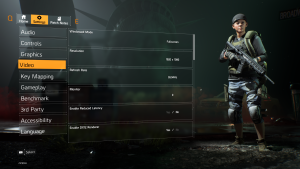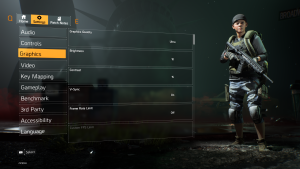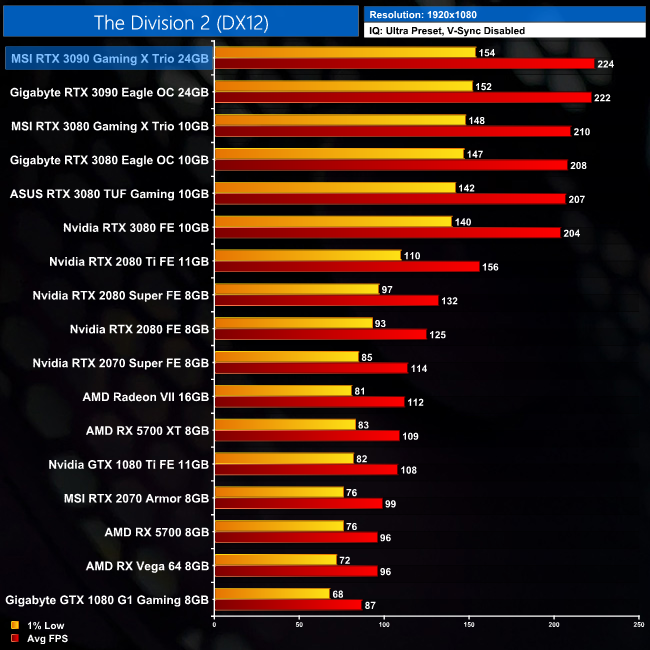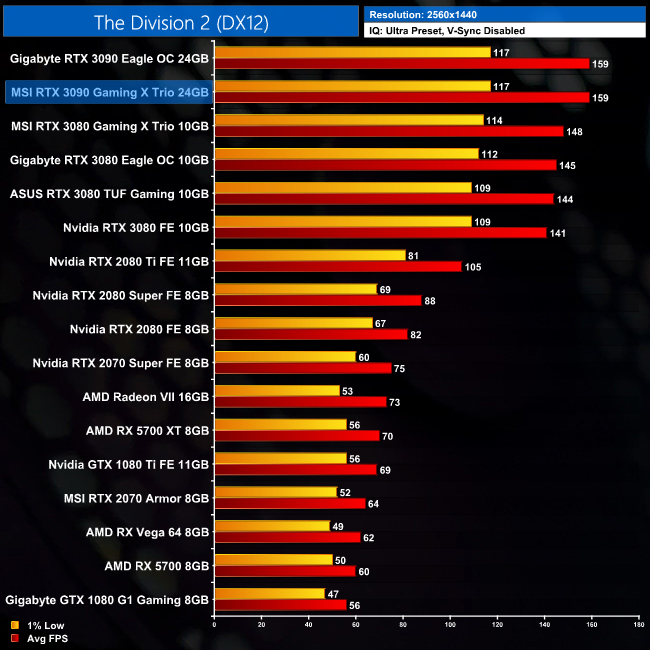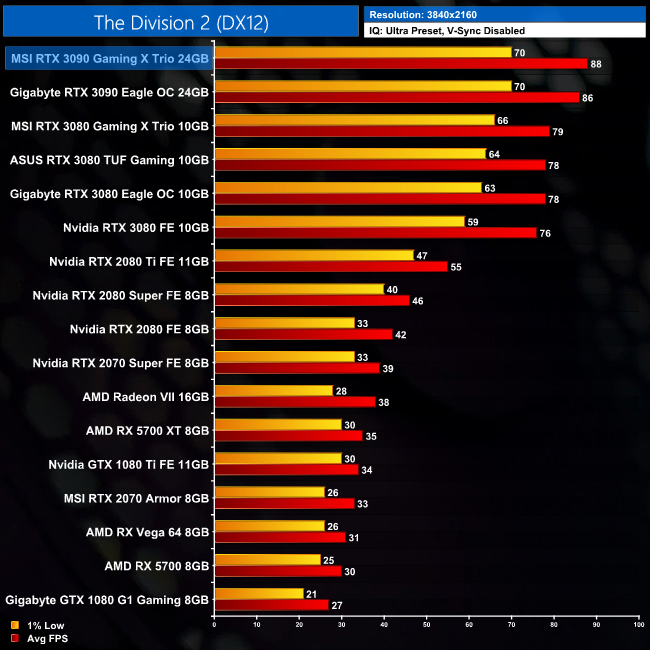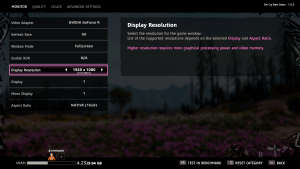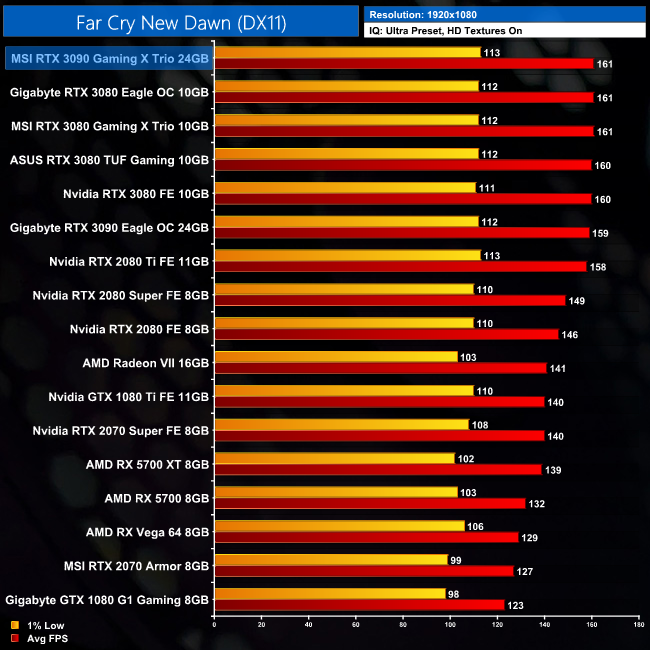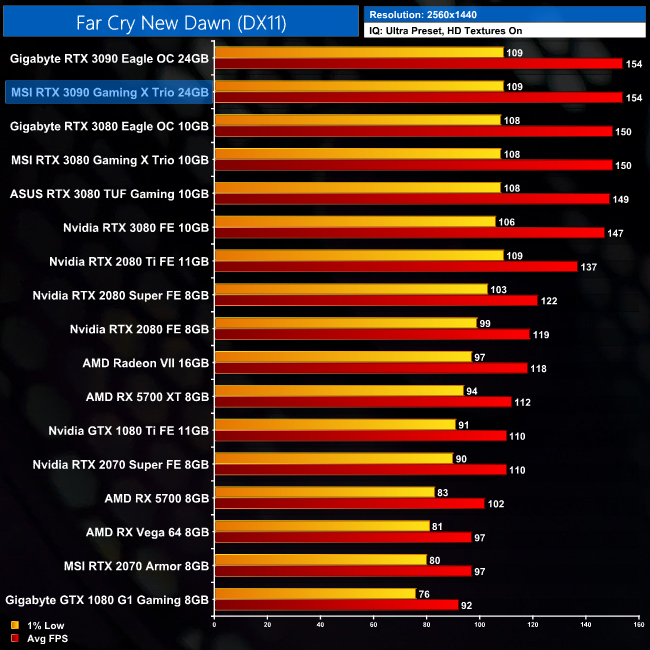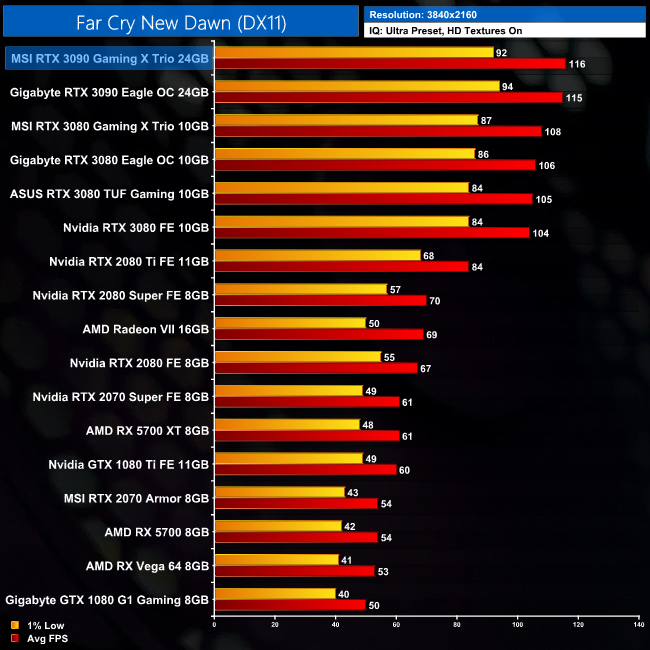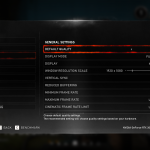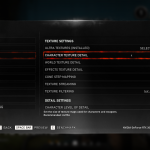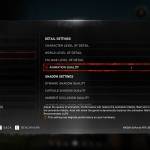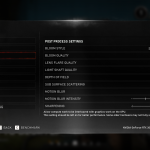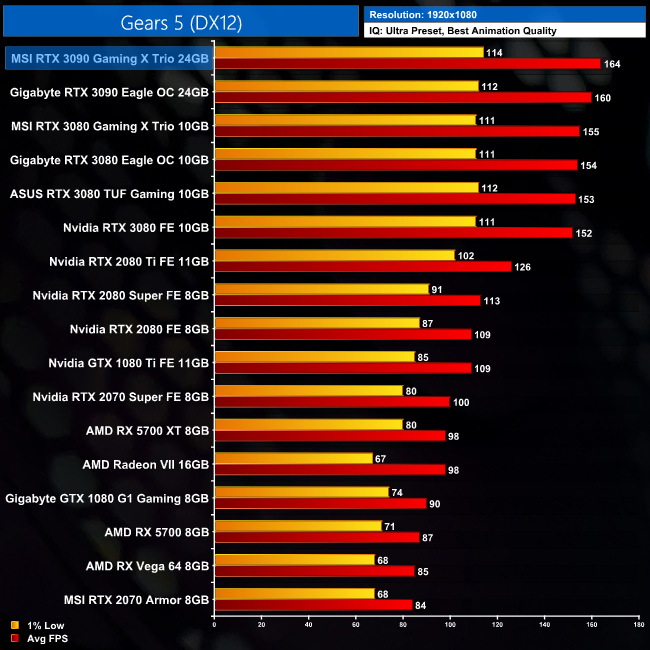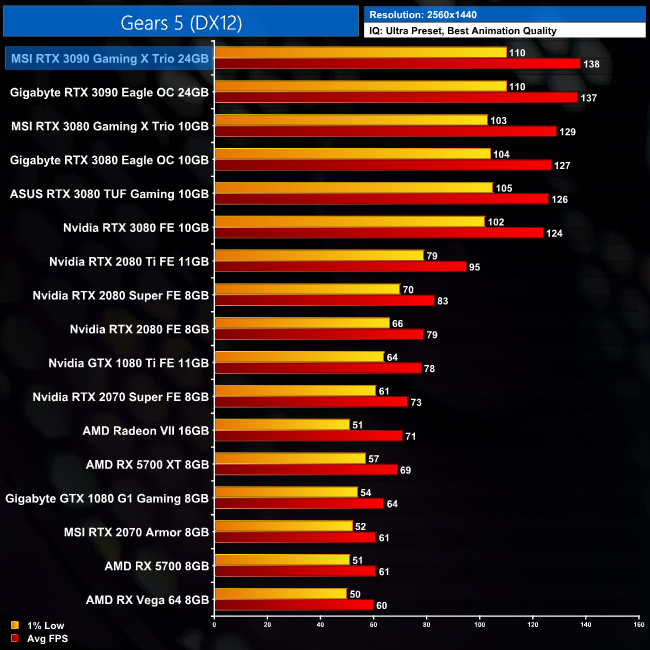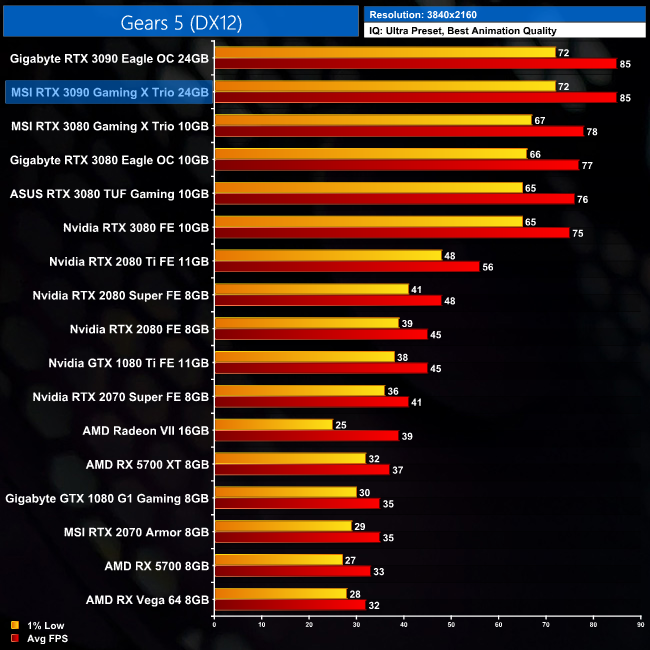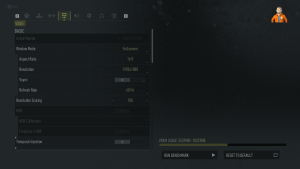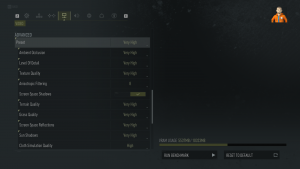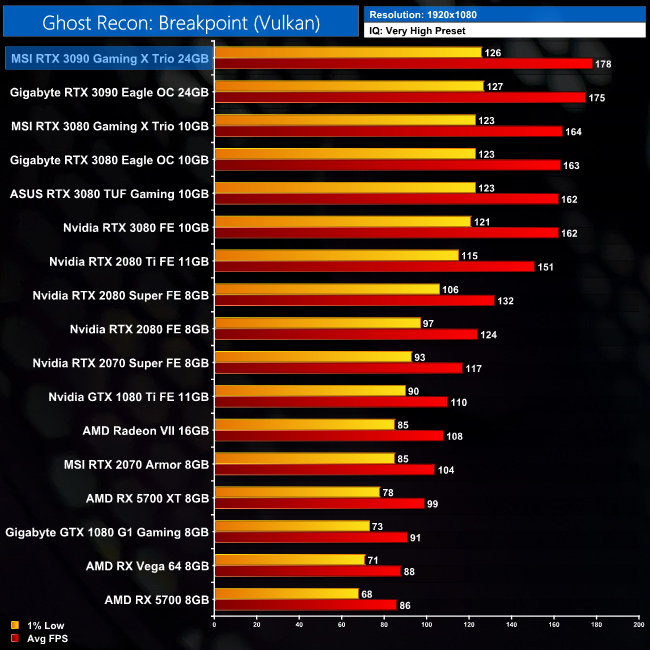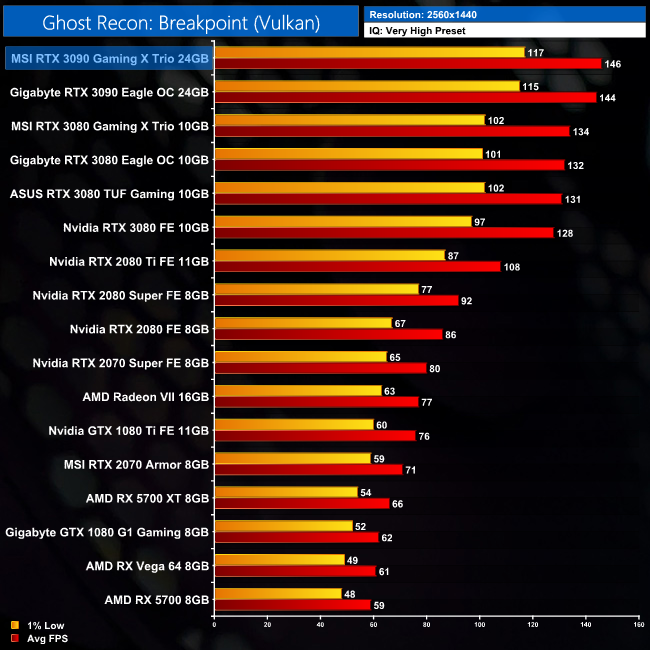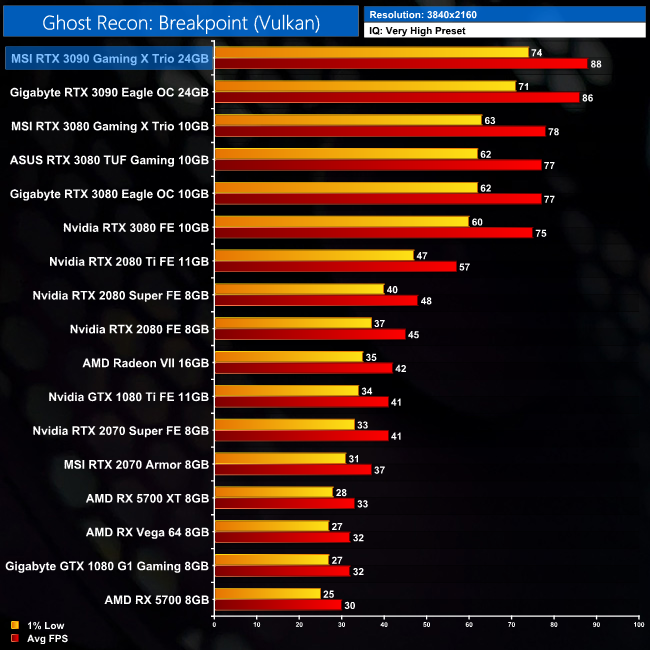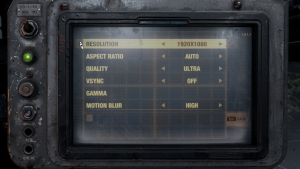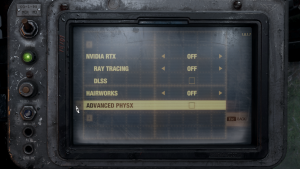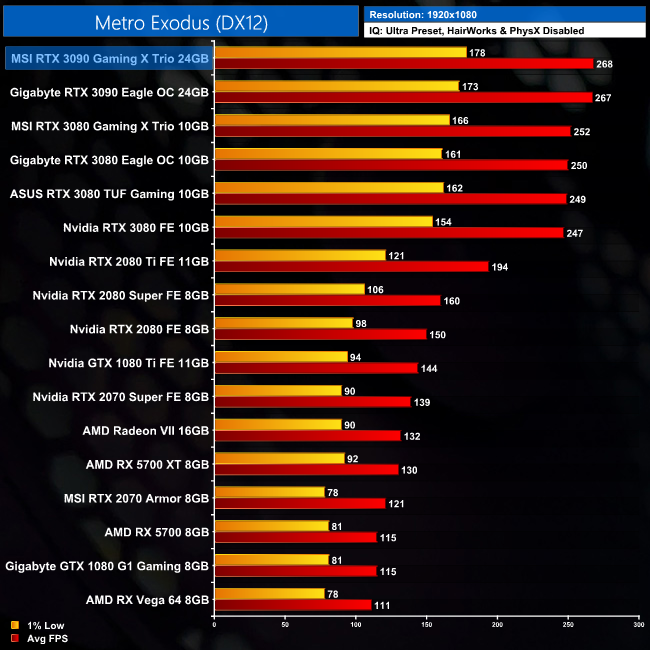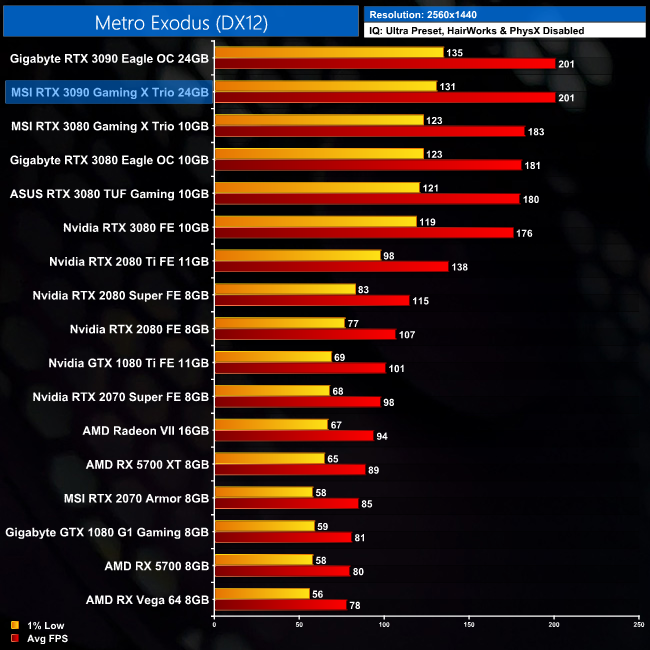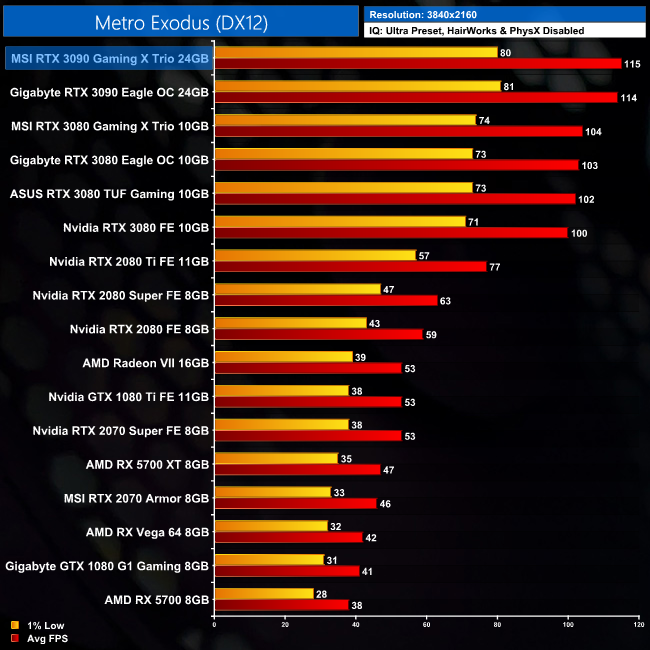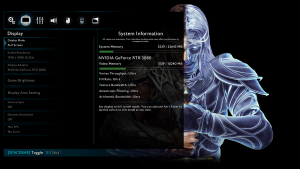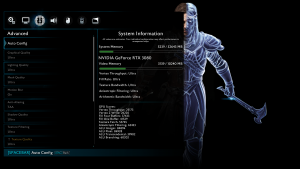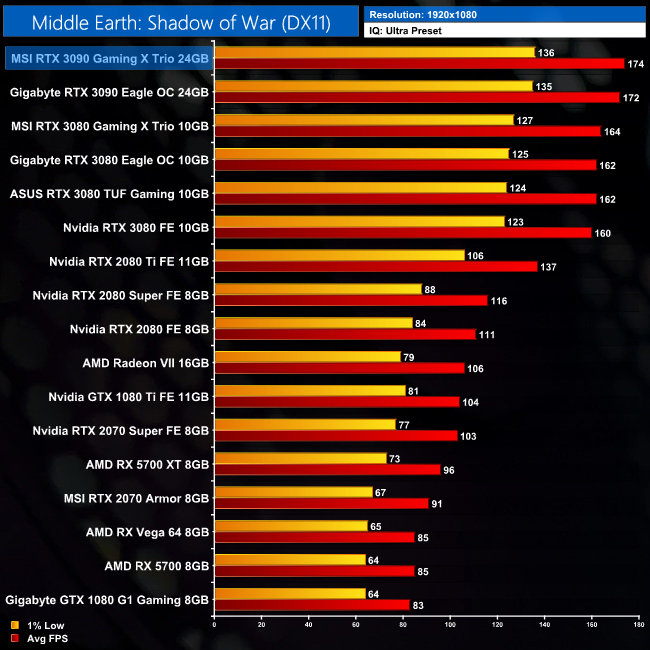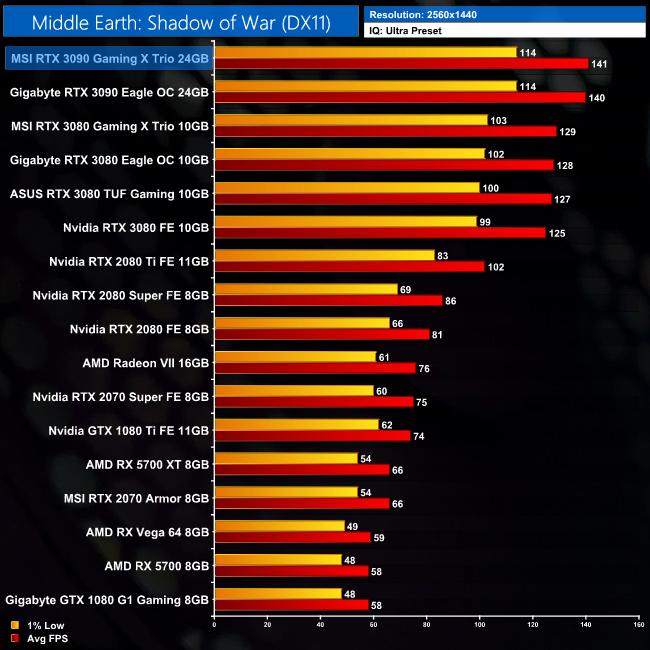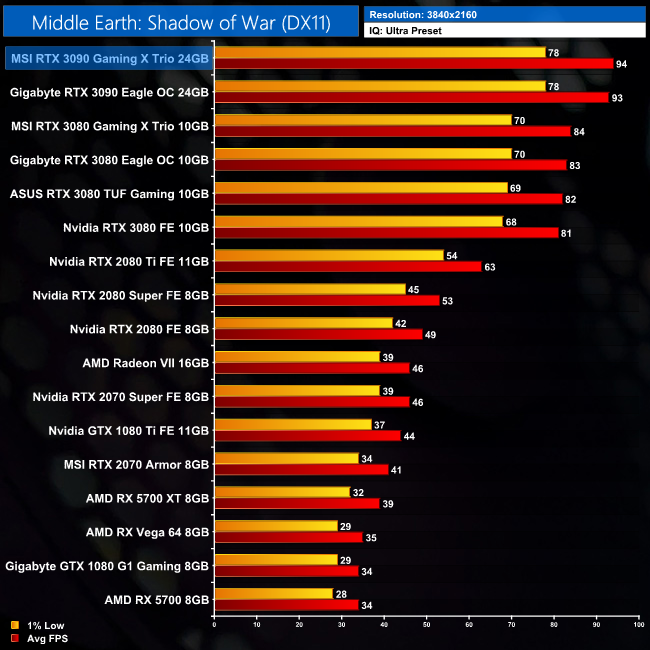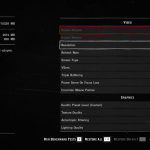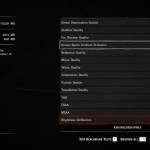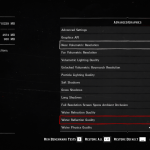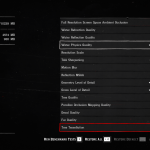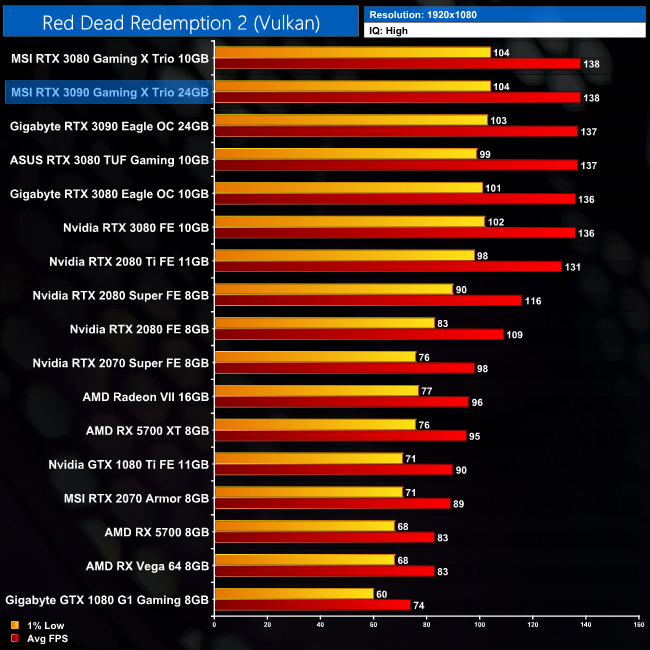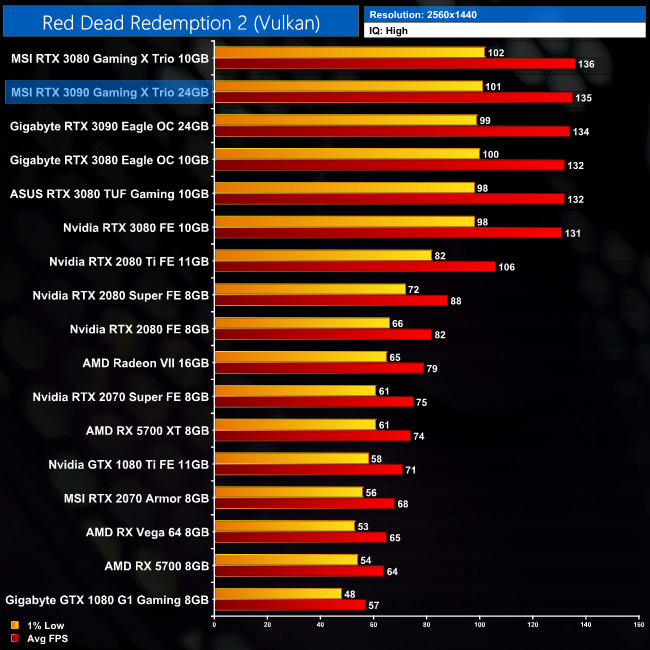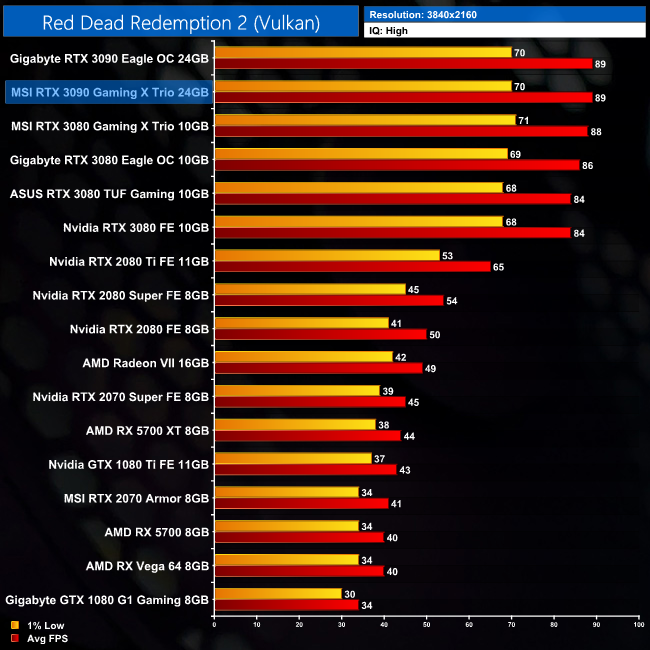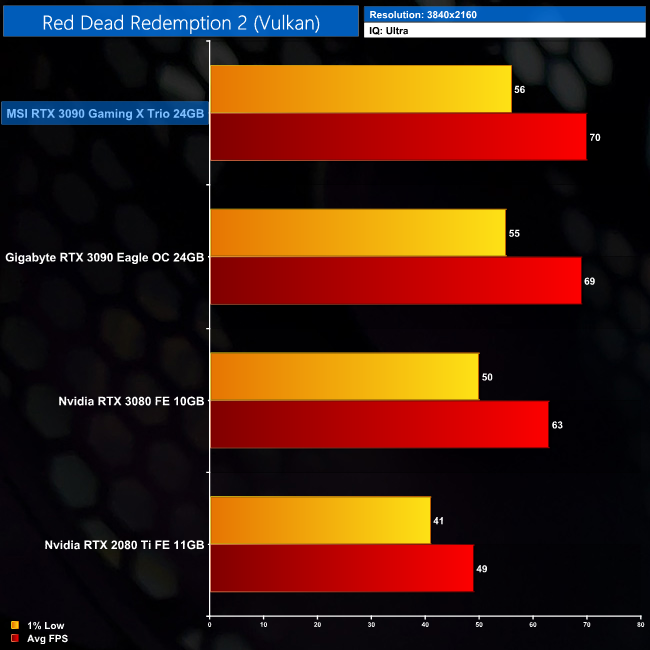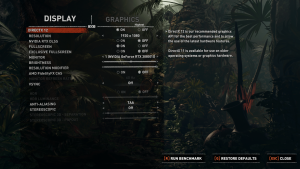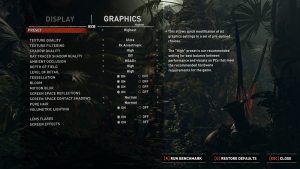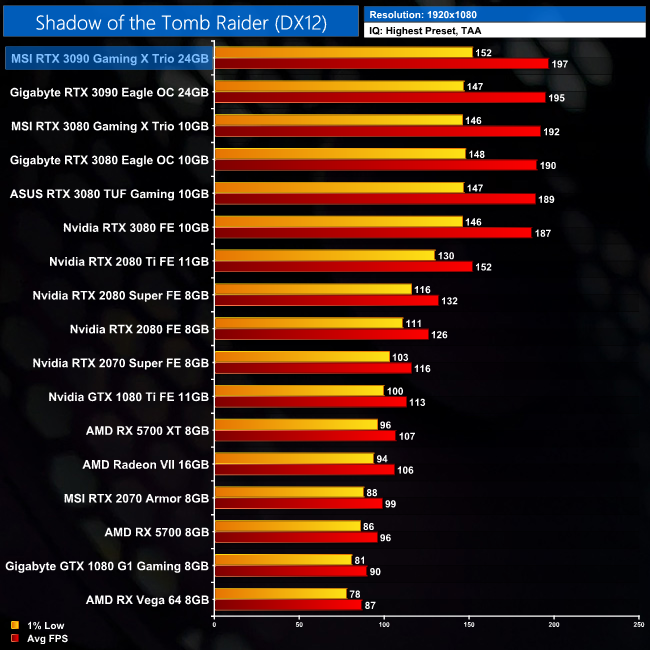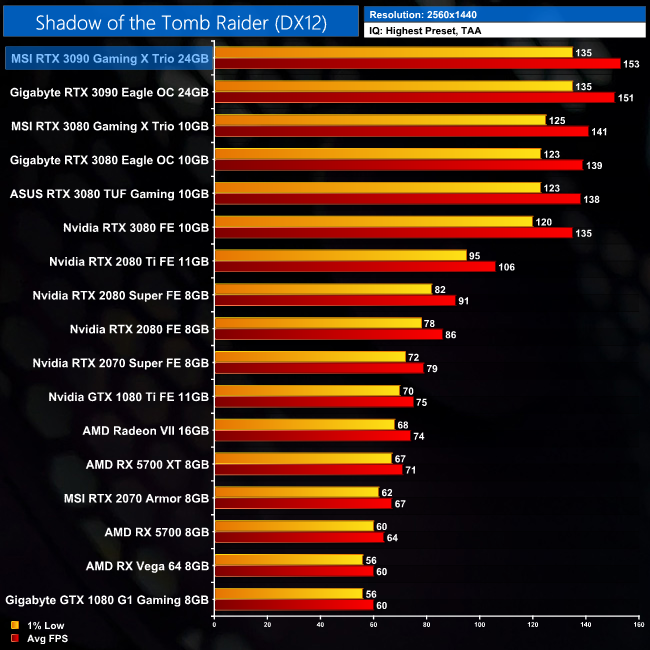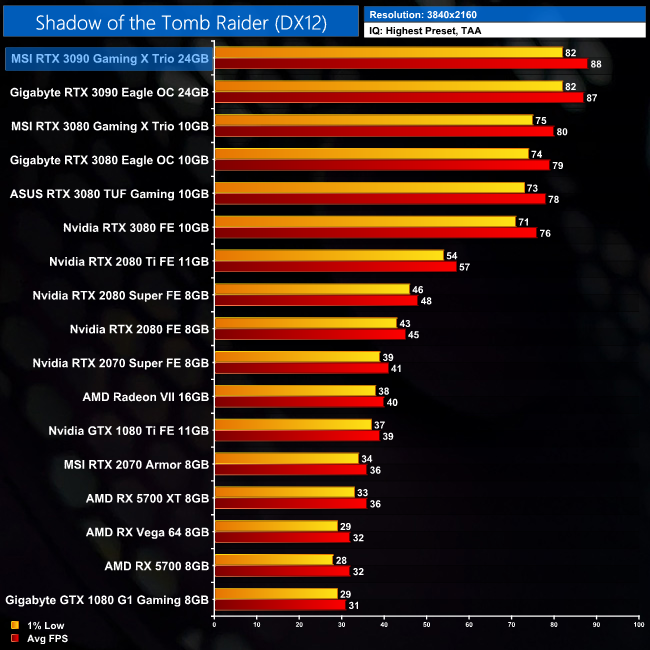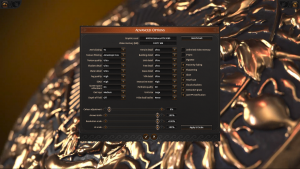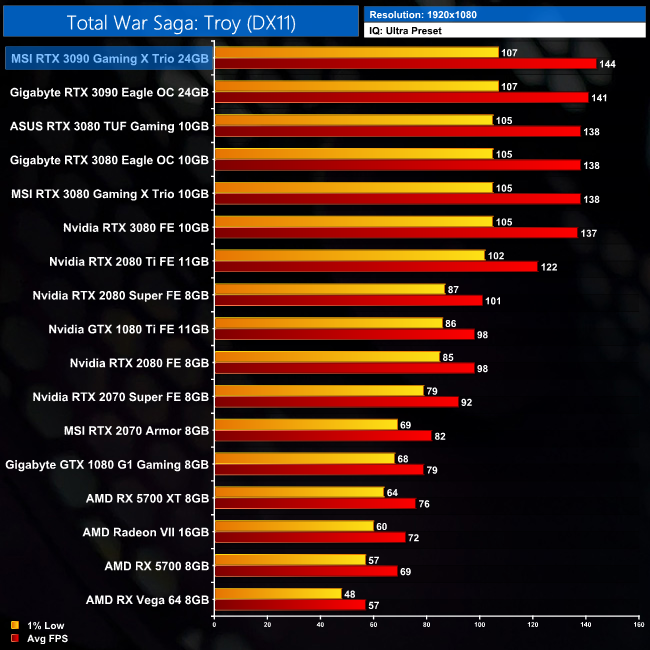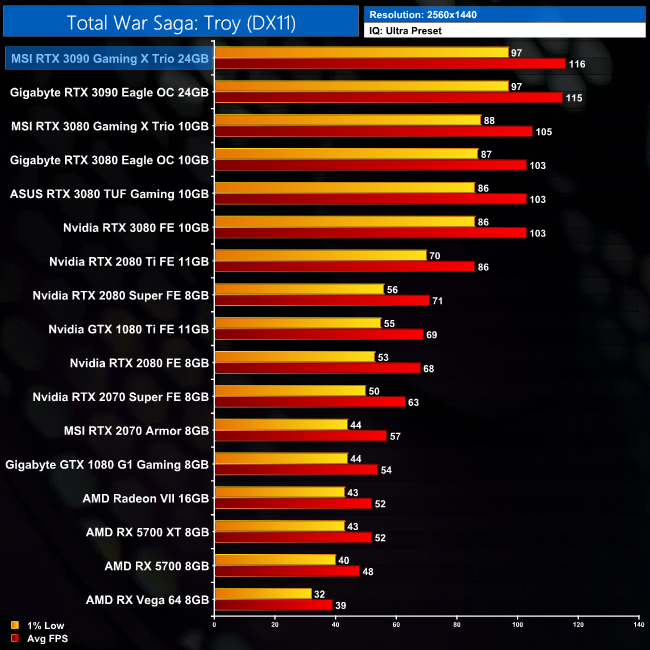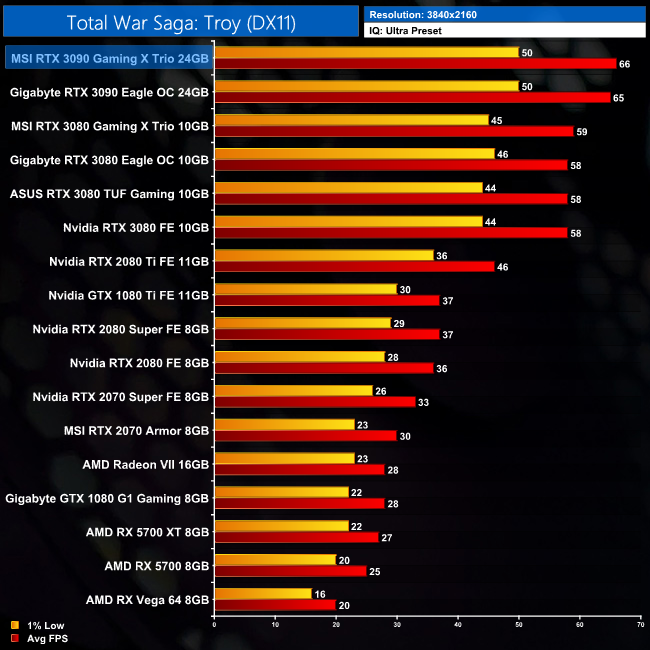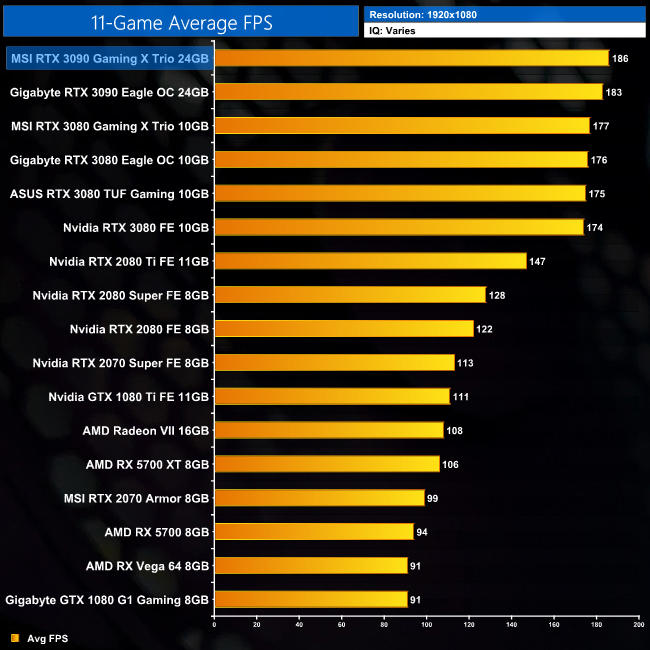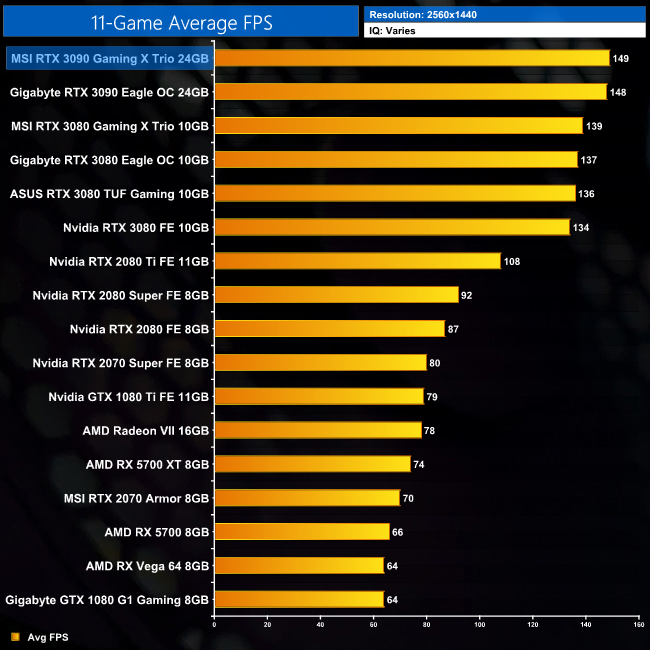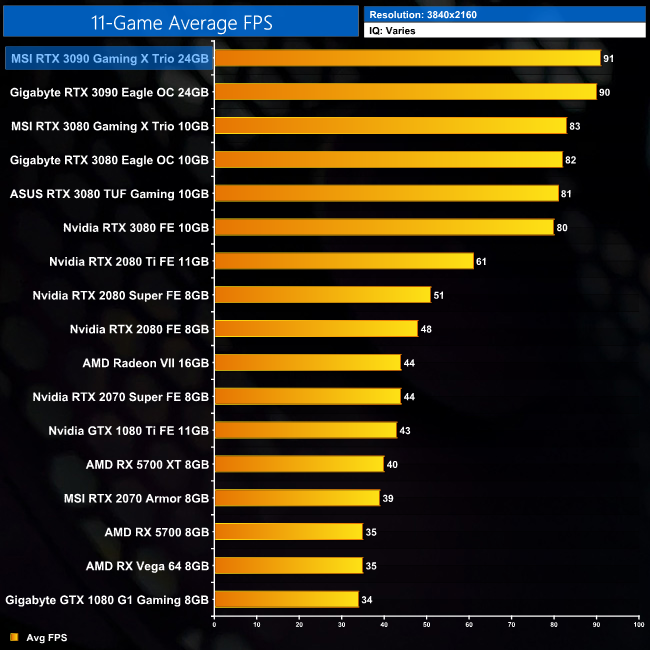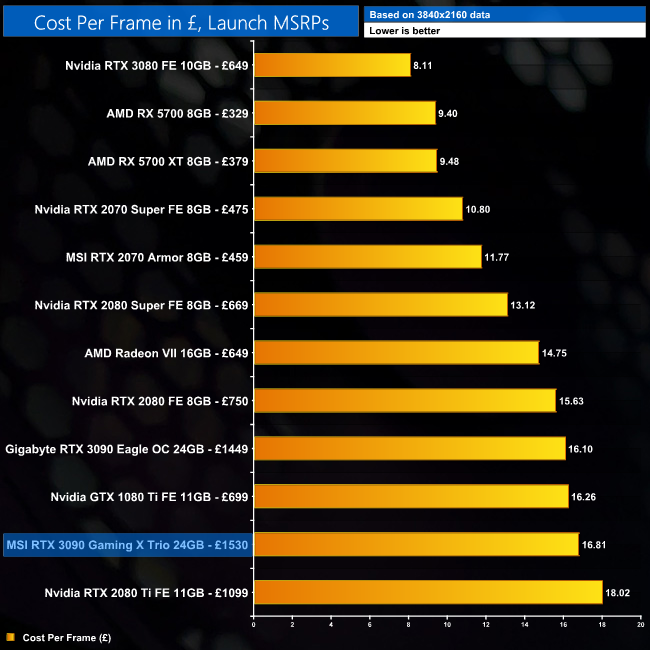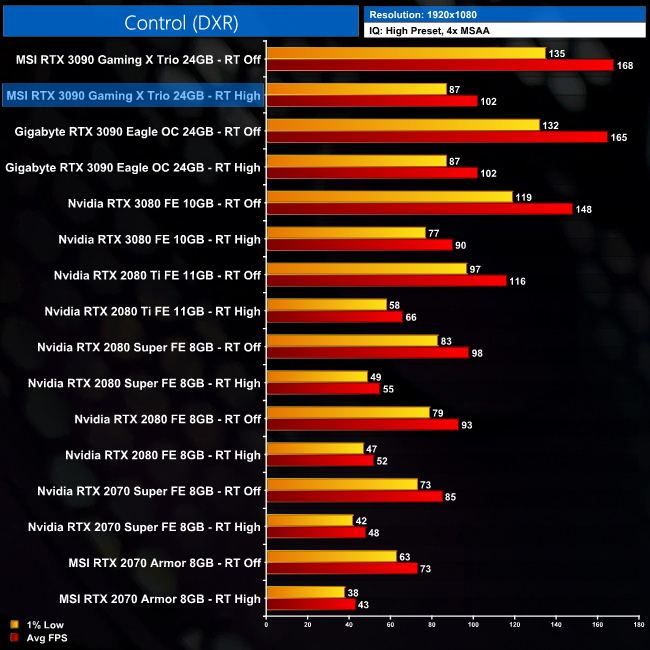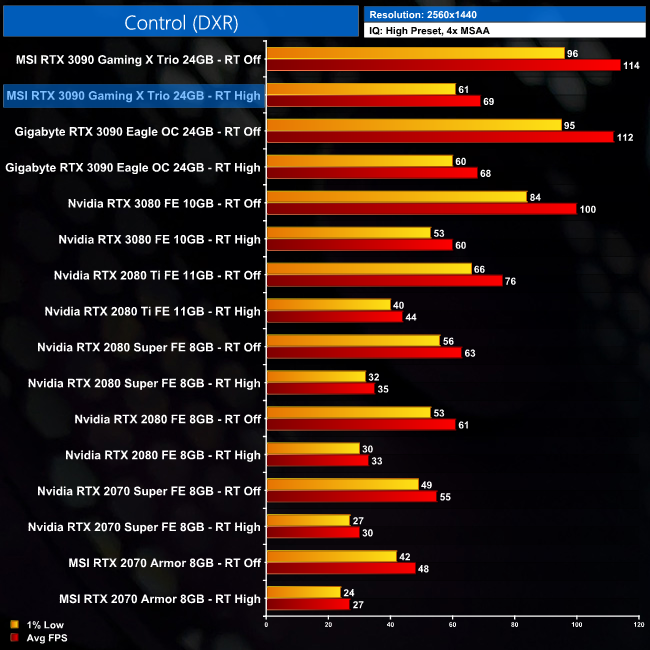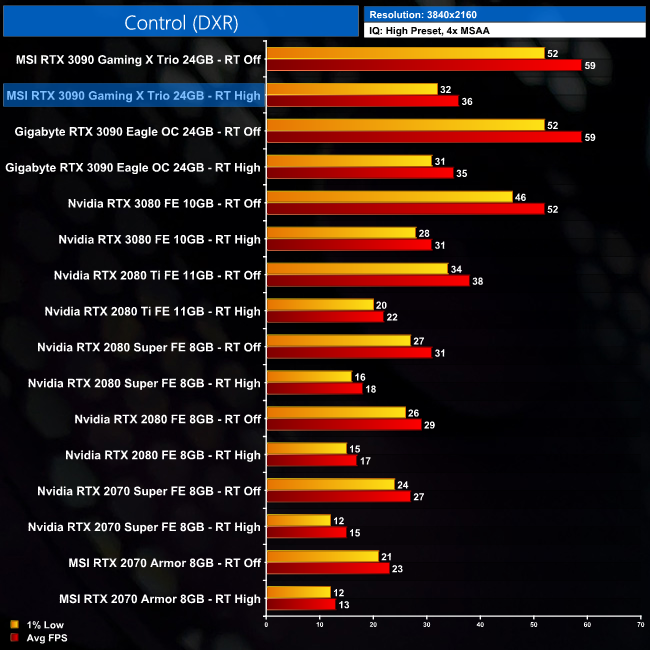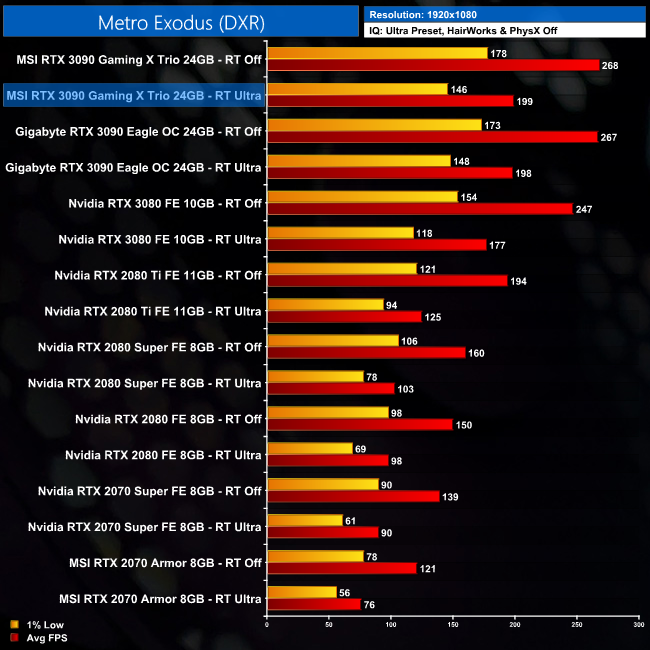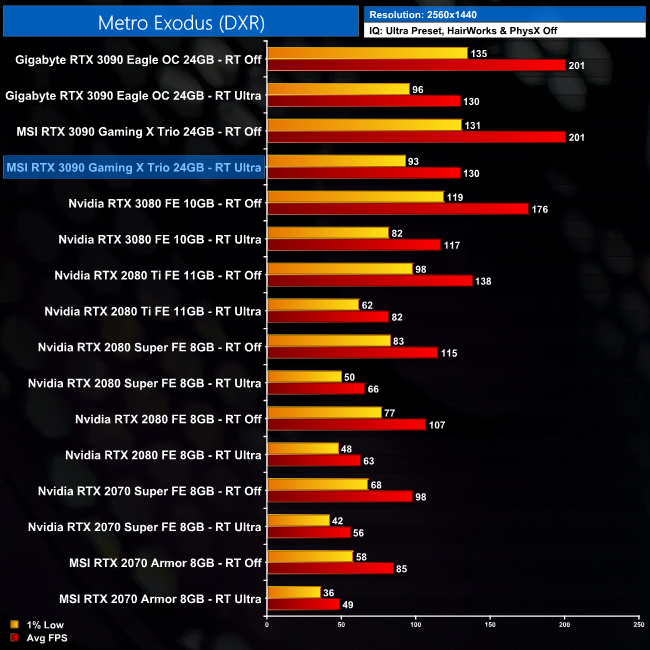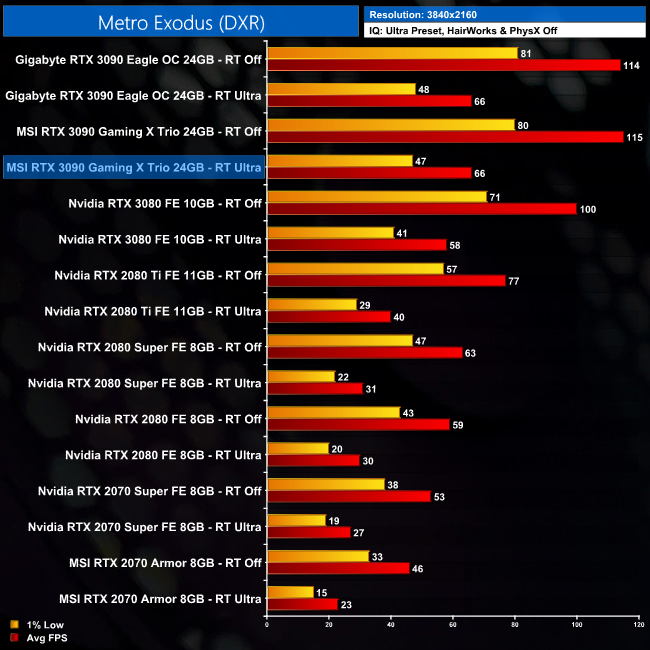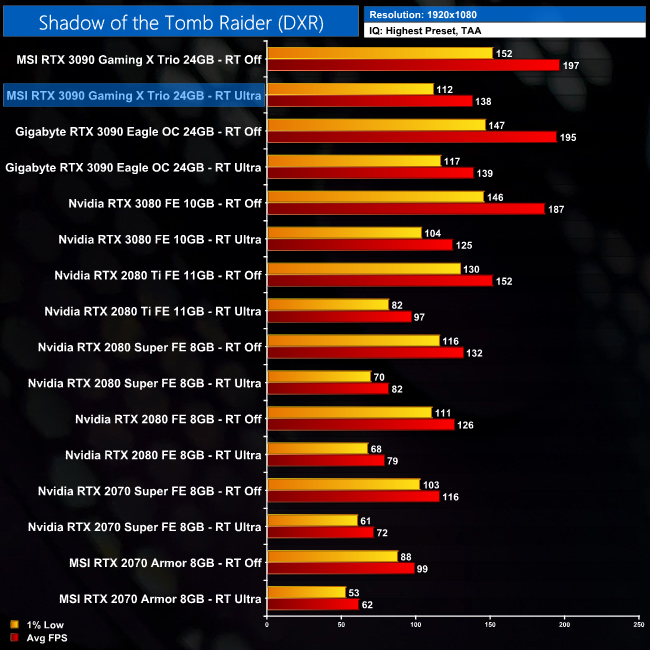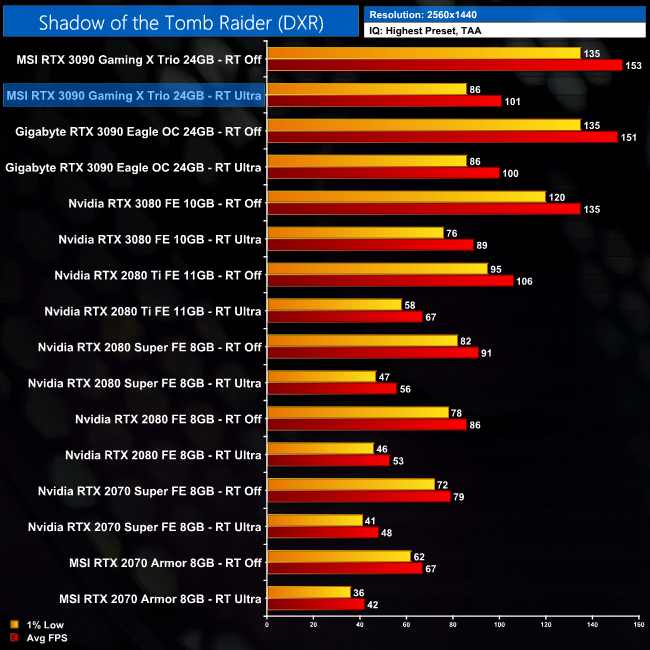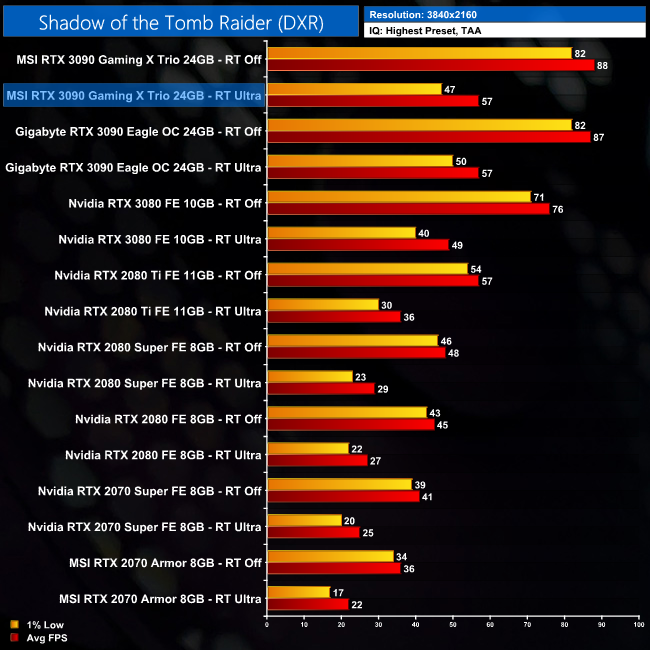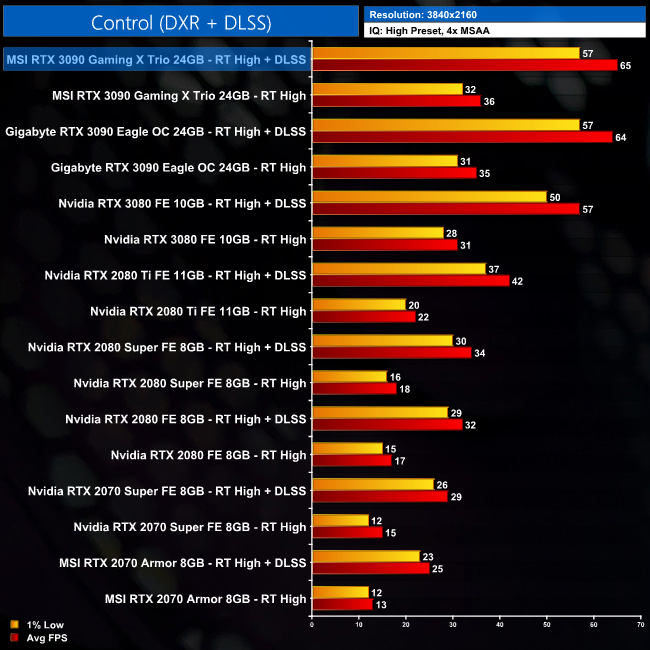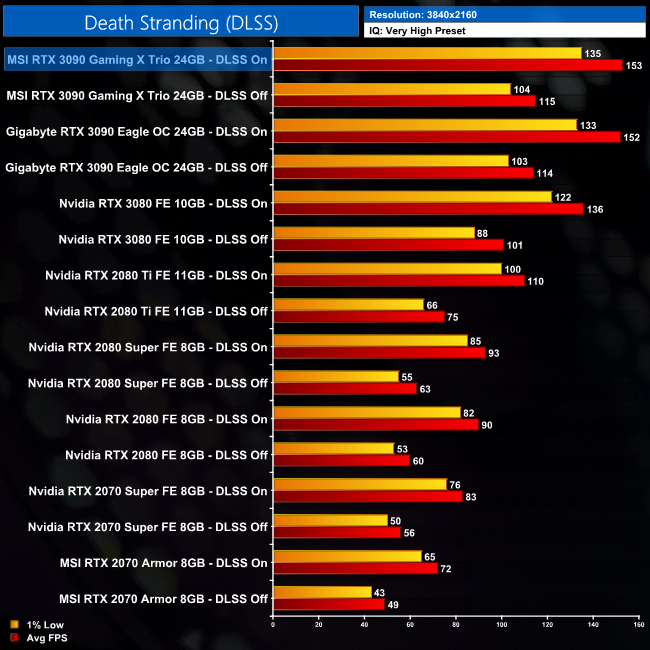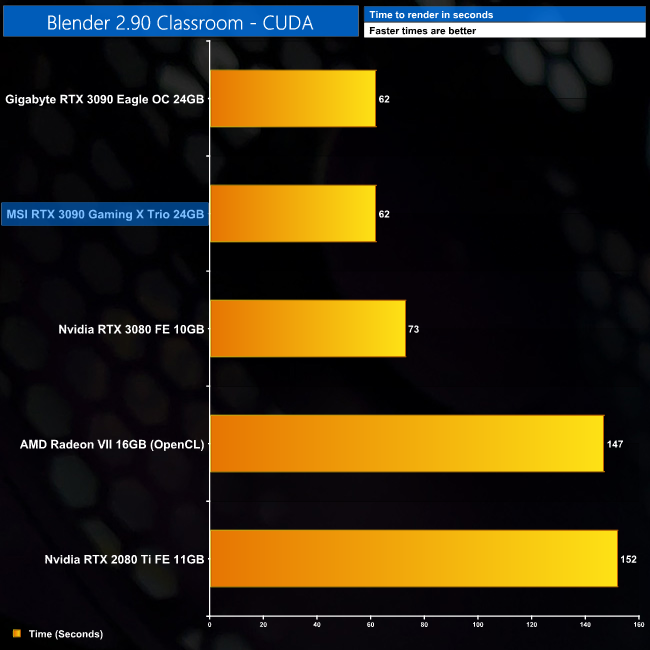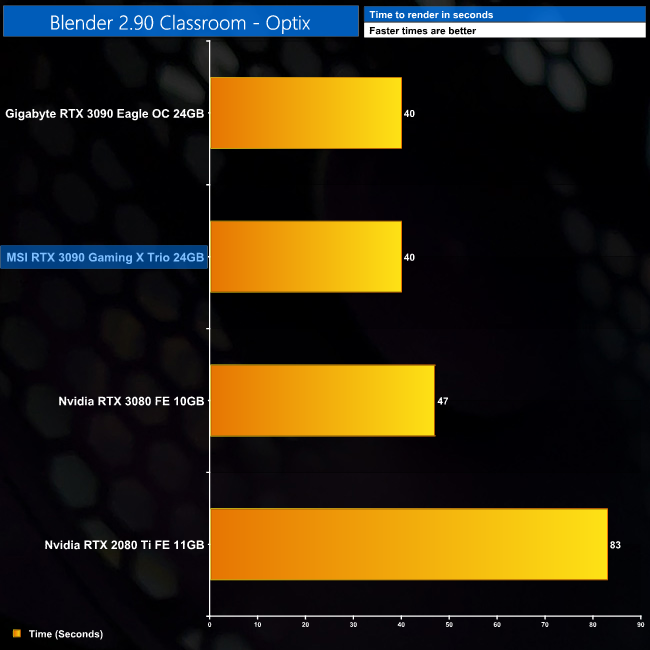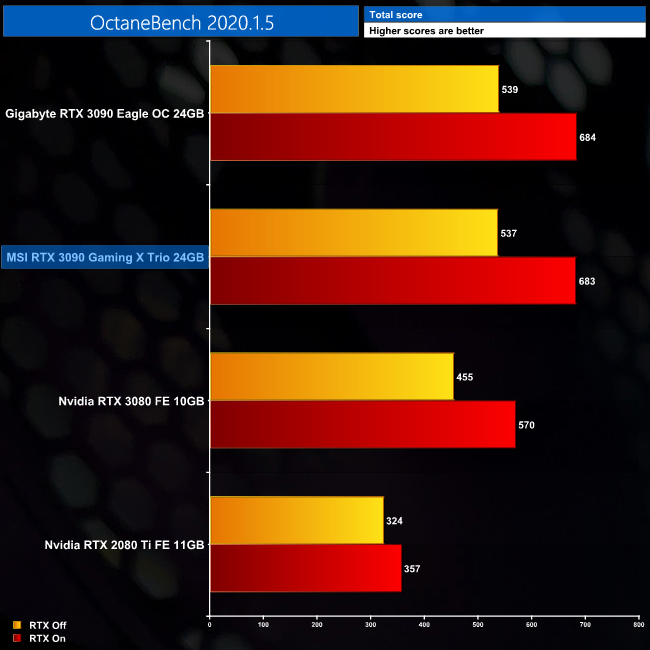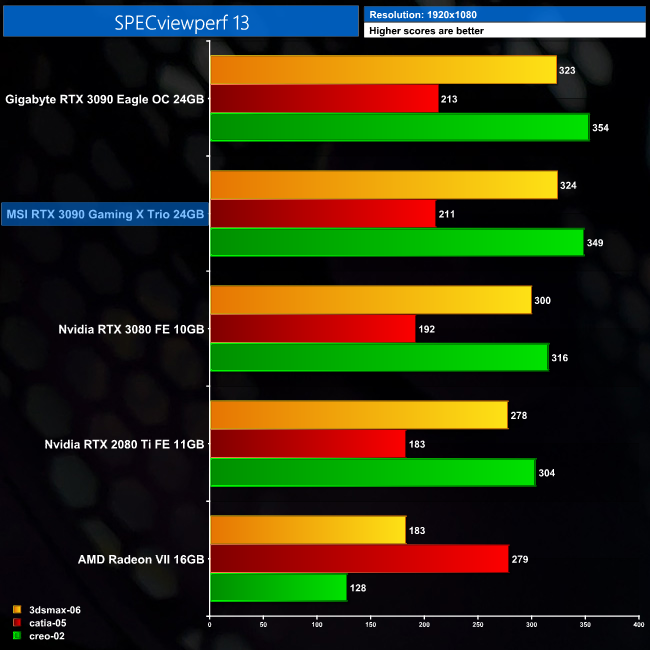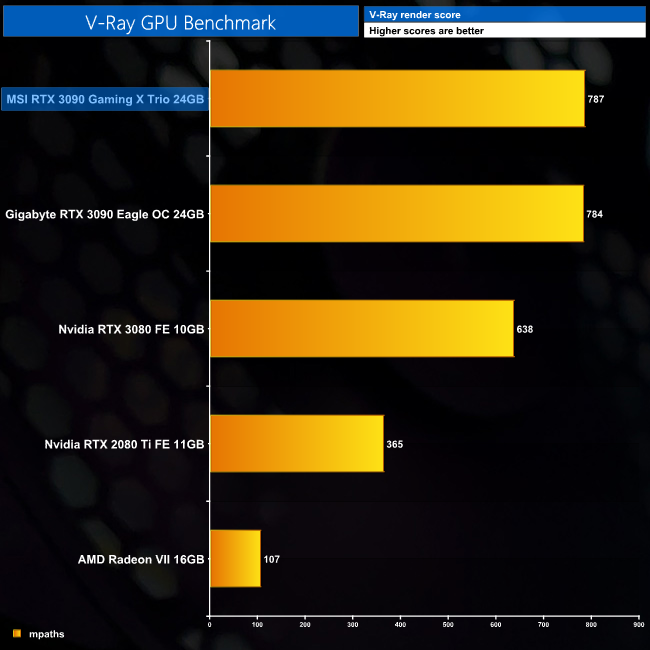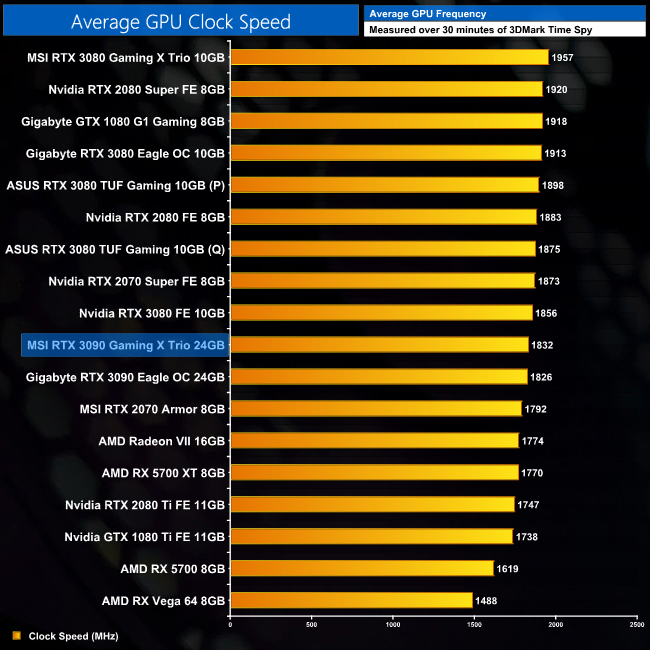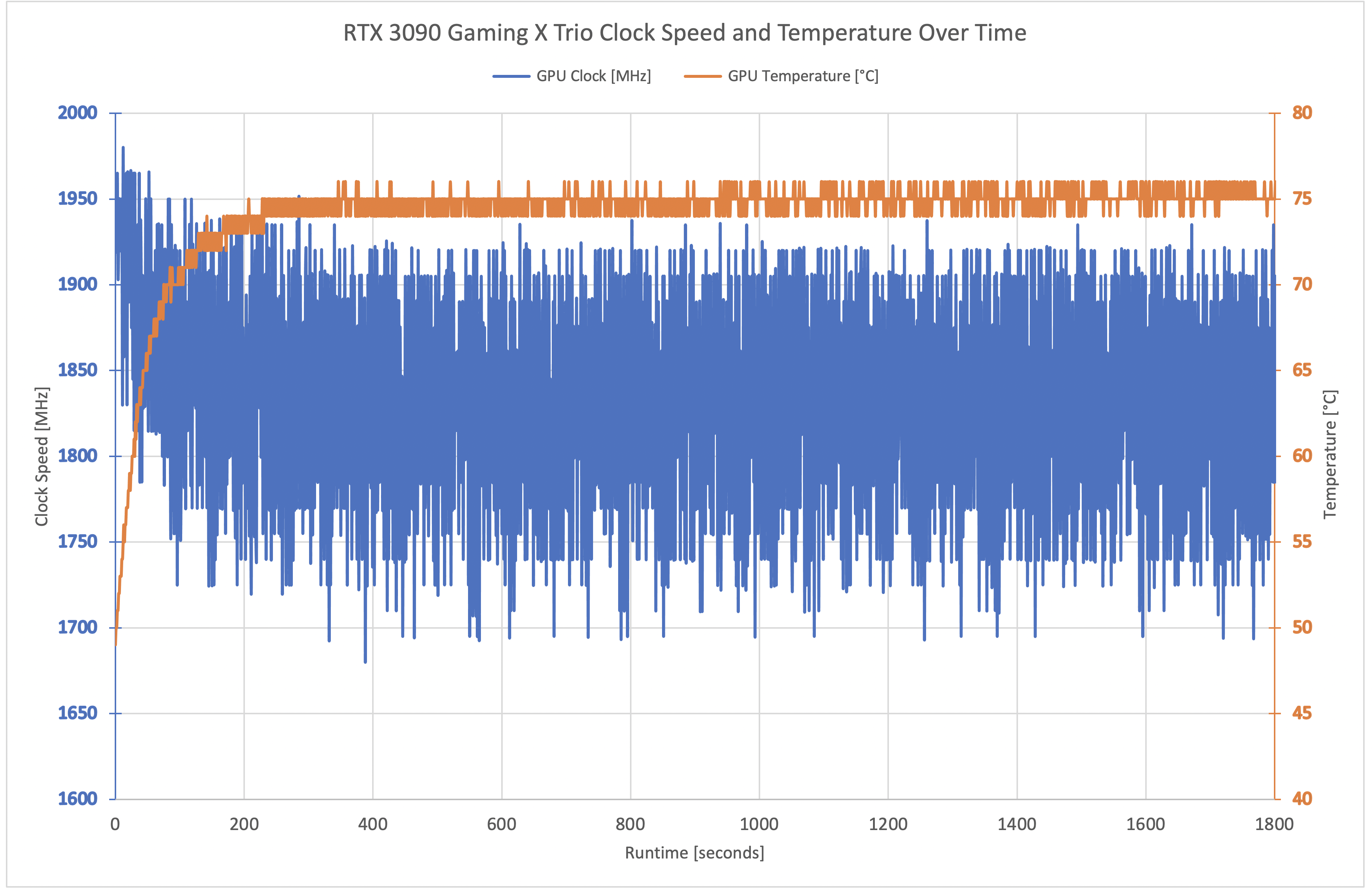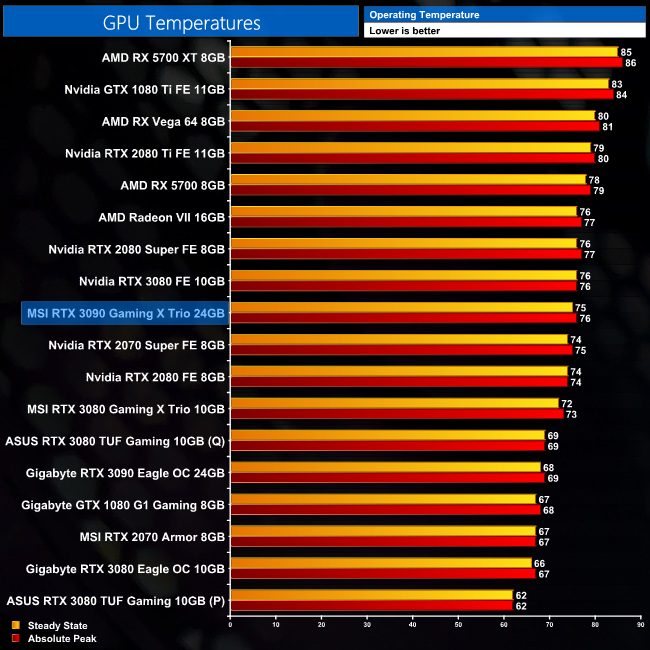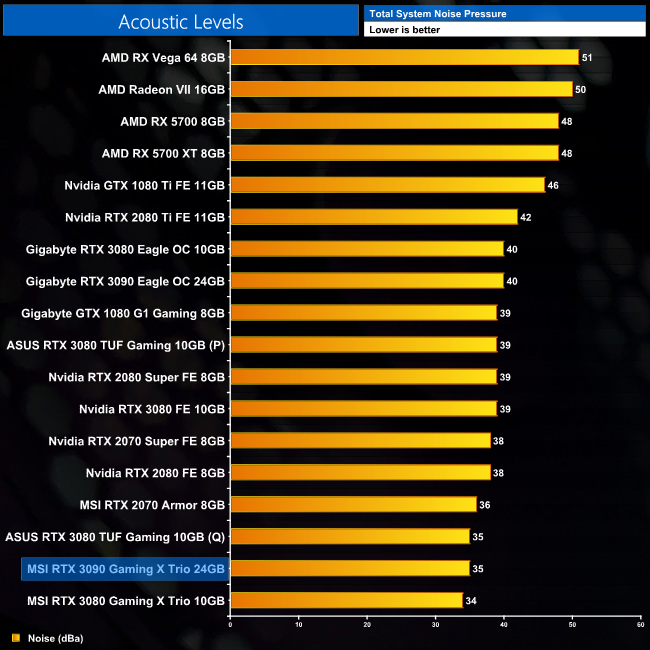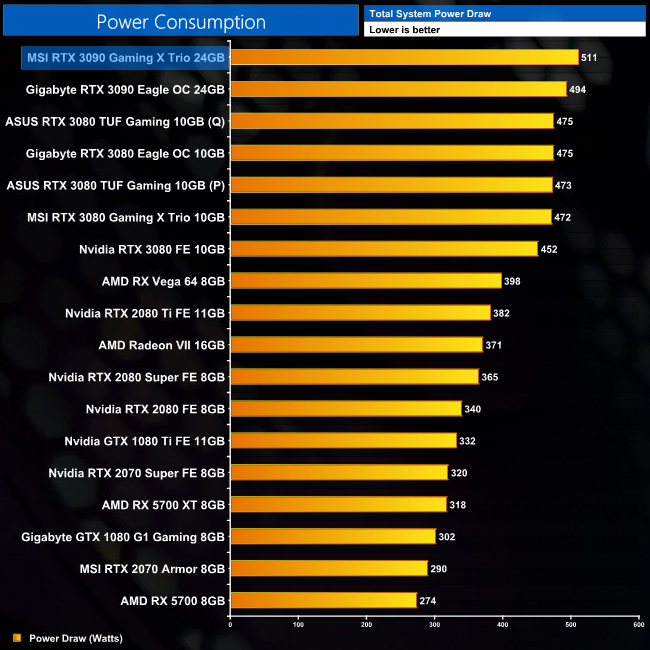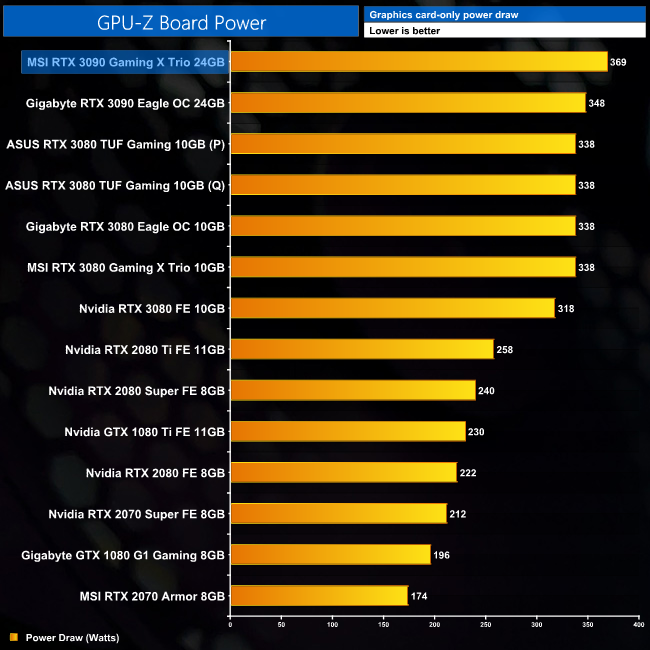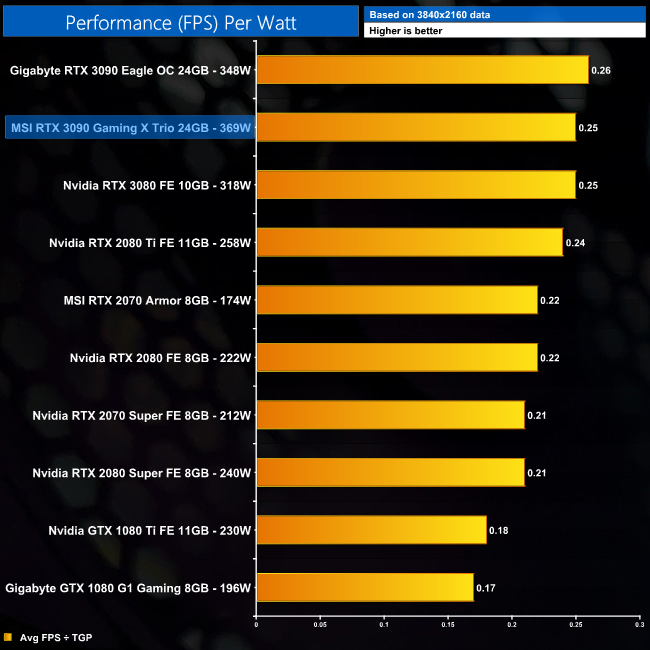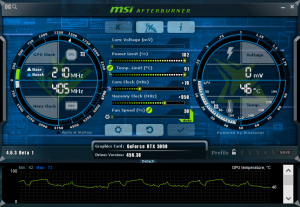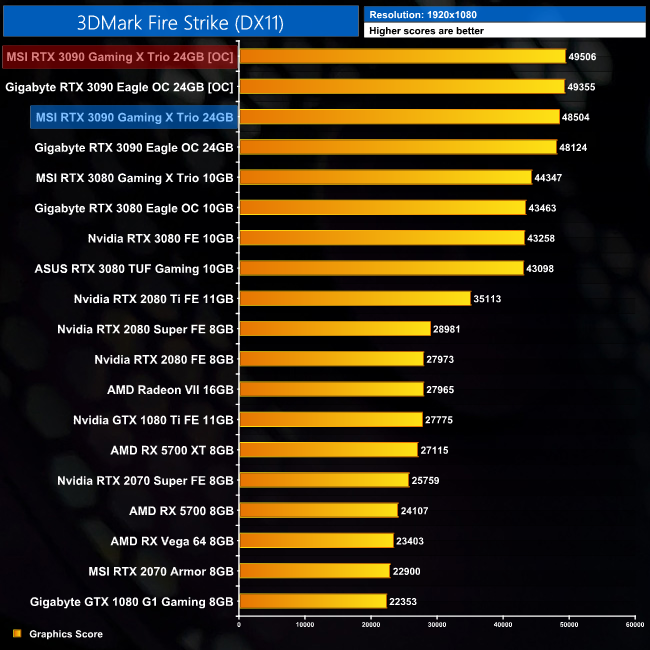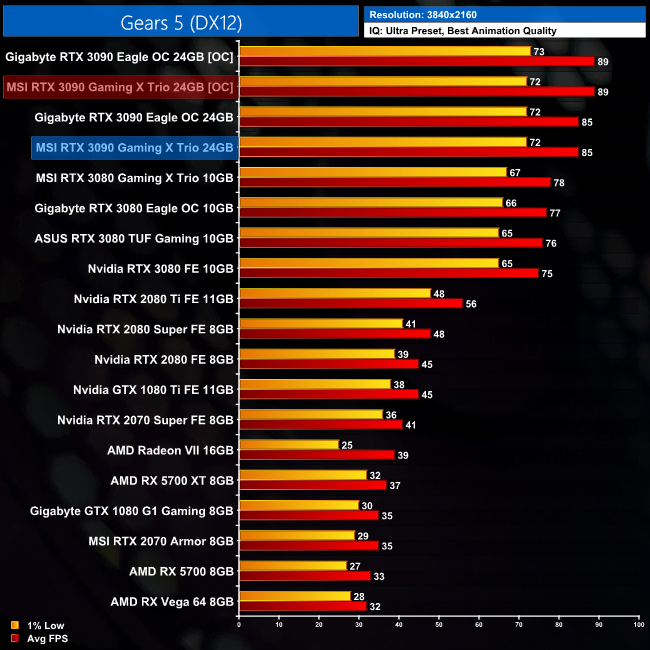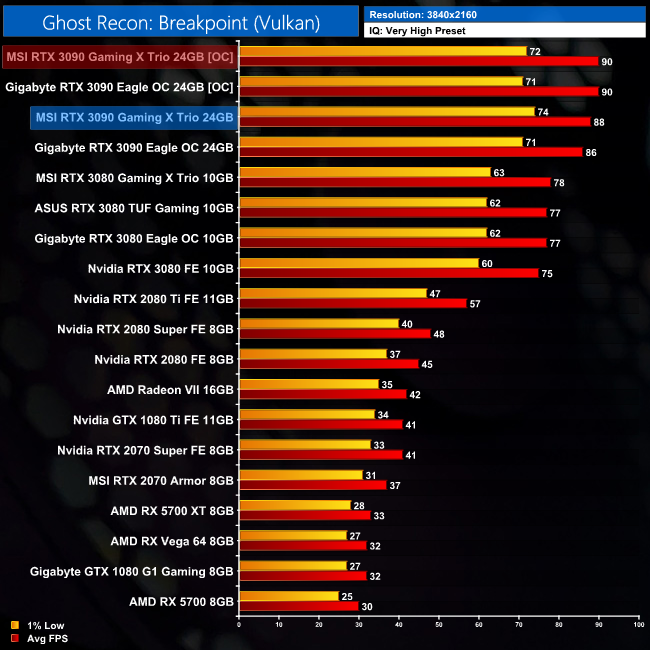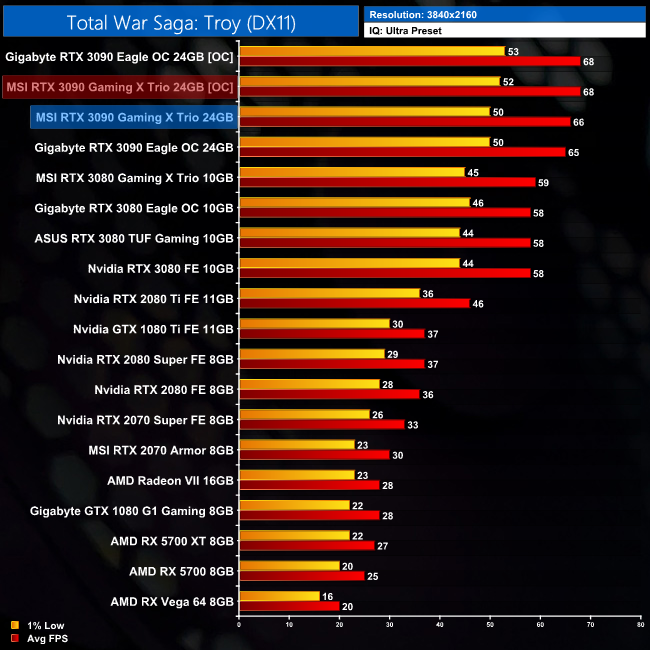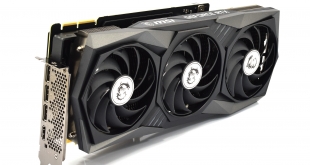
It's been a busy few weeks since Jensen Huang first announced the RTX 30-series in a live-streamed event from his kitchen. Last week saw the arrival of the RTX 3080, and today we are already moving on to look at the RTX 3090. While Nvidia specifically didn't call this their ‘flagship' GPU, it sits right at the top of the RTX 30-series stack, with a mammoth 10496 CUDA cores, 24GB GDDR6X memory and 350W TGP. This review is focusing on MSI's RTX 3090 Gaming X Trio model, priced at £1529.99.
Considering we reviewed the MSI RTX 3080 Gaming X Trio just last week, there may be a sense of déjà vu when looking at the RTX 3090 Gaming X Trio, as externally nothing appears to have changed. What has changed, is the configuration of the G102 GPU, so let's recap the core spec of this monster of a GPU.
| GPU | RTX 3090 | RTX 3080 | RTX 2080 Ti (FE) | RTX 2080 SUPER | RTX 2080 (FE) |
| SMs | 82 | 68 | 68 | 48 | 46 |
| CUDA Cores | 10496 | 8704 | 4352 | 3072 | 2944 |
| Tensor Cores | 328 | 272 | 544 | 384 | 368 |
| RT Cores | 82 | 68 | 68 | 48 | 46 |
| Texture Units | 328 | 272 | 272 | 192 | 184 |
| ROPs | 112 | 96 | 88 | 64 | 64 |
| GPU Boost Clock | 1695 MHz | 1710 MHz | 1635 MHz | 1815 MHz | 1800 MHz |
| Memory Data Rate | 19.5 Gbps | 19 Gbps | 14 Gbps | 15.5 Gbps | 14 Gbps |
| Total Video Memory | 24GB GDDR6X | 10GB GDDR6X | 11GB GDDR6 | 8GB GDDR6 | 8GB GDDR6 |
| Memory Interface | 384-bit | 320-bit | 352-bit | 256-bit | 256-bit |
| Memory Bandwidth | 936 GB/Sec | 760 GB/Sec | 616 GB/sec | 496.1 GB/sec | 448 GB/sec |
| TGP | 350W | 320W | 260W | 250W | 225W |
RTX 3090 uses the GA102 GPU, which also forms the basis for RTX 3080. Even with its 82 SMs, however, this is not actually a full implementation of GA102, as a fully populated die houses 84 SMs, so just two are missing from the RTX 3090. Ampere has doubled the number of FP32 shaders per SM, so there's a total of 128 CUDA Cores in each of those 82 SMs, for a grand total of 10496.
Each SM also houses a single RT Core, as well as four Tensor cores, giving us 328 with the RTX 3090. Additionally, there's 328 texture units and 112 ROPs.
As for the memory, this is a significant step up from the RTX 3080. RTX 3090 of course still uses GDDR6X memory, but it has over double the amount with 24GB. Additionally, the modules are clocked slightly faster at 19.5Gbps, and the memory interface is also slightly wider than RTX 3080, with a 384-bit interface. Total memory bandwidth comes in just shy of 1TB/s, hitting 936 GB/s.
Finally, we can see MSI has pushed the clock speed slightly further than reference. RTX 3090 defaults to a boost clock of 1695MHz, but MSI has added an extra 90MHz to this figure, bringing it up to 1785MHz. Later in the review we test exactly how fast this GPU actually operates, as we would expect GPU Boost to bring clock speed well above the rated speed.
The MSI RTX 3090 Gaming X Trio ships in a dark box, with a large image of the graphics card visible on the front.
On the back, MSI has highlighted a five key features of its Gaming X Trio card, including the Tri Frozr 2 cooler, Torx 4.0 fan design and Dragon Center software.
In the box, we get a total of five booklets and leaflets, including a quick start guide and warranty information. Additionally, a large GPU support bracket has also been included, which should help reduce GPU sag.
As we already mentioned, externally this RTX 3090 Gaming X Trio appears identical to its RTX 3080 brother. MSI is uses the same plastic shroud, with a fairly aggressive design, but as it is made of grey and black plastic it is entirely colour neutral.
The Tri Frozr 2 cooler is also back, with three Torx 4.0 fans, each of which measure approximately 90mm. These also feature a new design, where the fan blades come in pairs and are physically linked, which MSI says helps to ‘focus' airflow.
Below, we take a closer look at the heatsink design.
There's no getting around the fact that this is a huge graphics card, which is why a support bracket was deemed necessary. It measures 323 x 140 x 56mm.
The only change to the physical design of the card, compared to its RTX 3080 counterpart, is the backplate. With the RTX 3080 Gaming X Trio, MSI uses a graphene composite for the backplate, but this has been removed in favour of a metal backplate as we will see below. It's still a full-length backplate, with the MSI dragon logo visible on the back, but we can also see a few small cut-outs in the metal towards the end of the card.
Additionally, we can get a look at the two small NVLink fingers positioned next to the I/O bracket. RTX 3090 is the only Ampere GPU with SLI support.
Power requirements remain at 3x 8-pin PCIe connectors. These, coupled with 75W from the PCIe slot, should be capable of delivering 525W of power.
As for the video outputs, we have three DisplayPort 1.4a connectors, and a solitary HDMI 2.1 port.
Moving onto the PCB, here MSI has kept the same board design as the RTX 3080 Gaming X Trio, but it has stepped up the power delivery. This 3090 now sports a total of 18 power stages, which are likely split with 15 for the GPU and 3 for the memory, though a 14+4 configuration is also possible.
Here, MSI is using ON Semi's NCP302045 MOSFETs, rated for average current up to 45A and peak current up to 70A. These are co-packaged power stage solutions that integrate the high-side and low-side MOSFETs with the driver into a single package.
For the memory, finding space for 24 modules is difficult, so board partners have placed 12 chips on either side of the PCB. This must be why MSI felt it necessary to switch to a metal backplate with the RTX 3090, to make sure its memory cooling was up to the task.
The memory modules are of course GDDR6X chips from Micron, labelled ‘D8BGX'. These run at 19.5 Gbps.
In terms of the heatsink, this is again unchanged from the RTX 3080 Gaming X Trio. This means two separate fin stacks are connected by 6x 6mm nickel-plated copper heatpipes, with seventh heatpipe measuring 8mm. These pipes make direct contact with the GPU die, with the thickest one directly in the middle, while the memory and VRM contact with additional plates via thermal pads.
Finally, that metal backplate even sports a couple of flattened copper heatpipes, which distribute the heat from the memory modules (via thermal pads) across the backplate itself.
Driver Notes
- All Nvidia GPUs (except RTX 3000) were benchmarked with the 452.06 driver.
- RTX 3080 was benchmarked with the 456.16 driver supplied to press.
- RTX 3090 was benchmarked with 456.38 public driver.
- All AMD GPUs were benchmarked with the Adrenalin 20.8.2 driver.
Test System
We test using the a custom built system from PCSpecialist, based on Intel's latest Comet Lake-S platform. You can read more about it over HERE, and configure your own system from PCSpecialist HERE.
| CPU |
Intel Core i9-10900K
Overclocked to 5.1GHz on all cores |
| Motherboard |
ASUS ROG Maximus XII Hero Wi-Fi
|
| Memory |
Corsair Vengeance DDR4 3600MHz (4 X 8GB)
CL 18-22-22-42
|
| Graphics Card |
Varies
|
| System Drive |
500GB Samsung 970 Evo Plus M.2
|
| Games Drive | 2TB Samsung 860 QVO 2.5″ SSD |
| Chassis | Fractal Meshify S2 Blackout Tempered Glass |
| CPU Cooler |
Corsair H115i RGB Platinum Hydro Series
|
| Power Supply |
Corsair 1200W HX Series Modular 80 Plus Platinum
|
| Operating System |
Windows 10 2004
|
Comparison Graphics Cards List
- ASUS RTX 3080 TUF Gaming OC 10GB
- Gigabyte RTX 3080 Eagle OC 10GB
- MSI RTX 3080 Gaming X Trio 10GB
- Nvidia RTX 3080 FE 10GB
- Nvidia RTX 2080 Ti FE 11GB
- Nvidia RTX 2080 Super FE 8GB
- Nvidia RTX 2080 FE 8GB
- Nvidia RTX 2070 Super FE 8GB
- MSI RTX 2070 Armor 8GB
- Nvidia GTX 1080 Ti FE 11GB
- Gigabyte GTX 1080 G1 Gaming 8GB
- AMD Radeon VII 16GB
- AMD RX 5700 XT 8GB
- AMD RX 5700 8GB
- AMD RX Vega 64 8GB
Software and Games List
- 3DMark Fire Strike & Fire Strike Ultra (DX11 Synthetic)
- 3DMark Time Spy (DX12 Synthetic)
- 3DMark Port Royal (DXR Synthetic)
- Control (DX12)
- Death Stranding (DX12)
- The Division 2 (DX12)
- Far Cry New Dawn (DX11)
- Gears 5 (DX12)
- Ghost Recon: Breakpoint (Vulkan)
- Metro: Exodus (DX12)
- Middle Earth: Shadow of War (DX11)
- Red Dead Redemption 2 (Vulkan)
- Shadow of the Tomb Raider (DX12)
- Total War Saga: Troy (DX11)
We run each benchmark/game three times, and present mean averages in our graphs. We use OCAT to measure average frame rates as well as 1% low values across our three runs.
3DMark Fire Strike is a showcase DirectX 11 benchmark designed for today’s high-performance gaming PCs. It is our [FutureMark’s] most ambitious and technical benchmark ever, featuring real-time graphics rendered with detail and complexity far beyond what is found in other benchmarks and games today.
MSI's RTX 3090 Gaming X Trio takes top spot in every 3DMark benchmark we ran. Its best result, relatively speaking, comes in 3DMark Fire Strike Ultra, where it is 16% faster than the RTX 3080 Founders Edition and 56% faster than the RTX 2080 Ti.
3DMark Port Royal is the world’s first dedicated real-time ray tracing benchmark for gamers. You can use Port Royal to test and compare the real-time ray tracing performance of any graphics card that supports Microsoft DirectX Raytracing. As well as benchmarking performance, 3DMark Port Royal provides a realistic and practical example of what to expect from ray tracing in upcoming games.
It's the same story for Port Royal, 3DMark's ray tracing benchmark – here we see the RTX 3090 Gaming X Trio come in 16% faster than the 3080 Founders Edition.
Control is an action-adventure video game developed by Remedy Entertainment and published by 505 Games. Control was released on 27 August 2019 for Microsoft Windows, PlayStation 4, and Xbox One. (Wikipedia).
Engine: Northlight Engine. We test using the High preset, with 4x MSAA, DX12 API.
For our game benchmarks, we start with Control, with the MSI RTX 3090 producing just under 60FPS on average when testing at 4K. This is still 13% ahead of the RTX 3080 Founders Edition, and 55% faster than the RTX 2080 Ti.
Death Stranding is an action game developed by Kojima Productions. It is the first game from director Hideo Kojima and Kojima Productions after their split from Konami in 2015. It was released by Sony Interactive Entertainment for the PlayStation 4 in November 2019 and by 505 Games for Windows in July 2020. (Wikipedia).
Engine: Decima. We test using the Very High preset, with TAA, DX12 API.
Hideo Kojima's Death Stranding is next, with RTX 3090 pushing well over 100FPS here. For the MSI Gaming X Trio, it's 14% faster than the RTX 3080 Founders Edition, and 53% faster than the RTX 2080 Ti.
Tom Clancy's The Division 2 is an online action role-playing video game developed by Massive Entertainment and published by Ubisoft. The sequel to Tom Clancy's The Division (2016), it is set in a near-future Washington, D.C. in the aftermath of a smallpox pandemic, and follows an agent of the Strategic Homeland Division as they try to rebuild the city. (Wikipedia).
Engine: Snowdrop. We test using the Ultra preset, but with V-Sync disabled, DX12 API.
At 4K, we can see RTX 3090 delivering just shy of 90FPS on average in The Division 2. This is a 60% improvement over the RTX 2080 Ti, and that's the biggest margin between these two GPUs across all of our game benchmarks today. Compared to the RTX 3080 Founders Edition, MSI's RTX 3090 is 16% ahead.Far Cry New Dawn is an action-adventure first-person shooter developed by Ubisoft Montreal and published by Ubisoft. The game is a spin-off of the Far Cry series and a narrative sequel to Far Cry 5. It was released for Microsoft Windows, PlayStation 4 and Xbox One on February 15, 2019. (Wikipedia).
Engine: Dunia 2. We test using the Ultra preset, with the HD Textures pack, DX11 API.
The margins tighten up somewhat in Far Cry New Dawn. Here, the MSI RTX 3090 is 38% faster than RTX 2080 Ti, and 12% faster than the RTX 3080 FE, when testing at 4K. It's still able to push almost 120FPS at this resolution, delivering a very smooth experience.
Gears 5 is a third-person shooter video game developed by The Coalition and published by Xbox Game Studios for Microsoft Windows and Xbox One. It is the sixth instalment of the Gears of War series, and is the second Gears of War game not to be developed by Epic Games.
Engine: Unreal Engine 4. We test using the Ultra preset, with Best Animation Quality (instead of Auto), DX12 API.
As for Gears 5, here the RTX 3090 hits 85FPS on average at 4K. This makes it 52% faster than the RTX 2080 Ti, and 13% faster than the RTX 3080 Founders Edition.
Tom Clancy's Ghost Recon Breakpoint is an online tactical shooter video game developed by Ubisoft Paris and published by Ubisoft. The game was released worldwide on 4 October 2019, for Microsoft Windows, PlayStation 4 and Xbox One, (Wikipedia).
Engine: AnvilNext 2.0. We test using the Very High preset, with AA disabled, Vulkan API.
Of all the games we tested for this review, Ghost Recon: Breakpoint delivers the single biggest improvement for the RTX 3090 when compared to the RTX 3080 Founders Edition – MSI's card is 17% faster at 4K.
Metro Exodus is a first-person shooter video game developed by 4A Games and published by Deep Silver in 2019. It is the third instalment in the Metro video game series based on Dmitry Glukhovsky's novels, following the events of Metro 2033 and Metro: Last Light. (Wikipedia).
Engine: 4A Engine. We test using the Ultra preset, but with Hairworks and Advanced PhysX turned off, DX12 API.
Hitting 115FPS on average, even at 4K, is no small achievement for the RTX 3090 in Metro Exodus. This puts it 15% ahead of the RTX 3080 Founders Edition.
Middle-earth: Shadow of War is an action role-playing video game developed by Monolith Productions and published by Warner Bros. Interactive Entertainment. It is the sequel to 2014’s Middle-earth: Shadow of Mordor, and was released worldwide for Microsoft Windows, PlayStation 4, and Xbox One on October 10, 2017. (Wikipedia).
Engine: LithTech Firebird. We test using the Very High preset, DX11 API.
Middle Earth: Shadow of War sees frame rates come in a little short of 100FPS, but the RTX 3090 is still 16% faster than the RTX 3080, and 49% faster than the RTX 2080 Ti, in this title.
Red Dead Redemption 2 is a 2018 action-adventure game developed and published by Rockstar Games. The game is the third entry in the Red Dead series and is a prequel to the 2010 game Red Dead Redemption. Red Dead Redemption 2 was released for the PlayStation 4 and Xbox One in October 2018, and for Microsoft Windows and Stadia in November 2019. (Wikipedia).
Engine: Rockstar Advance Game Engine (RAGE). We test by manually selecting High settings, not using a preset, including TAA, Vulkan API.
When testing Red Dead Redemption 2, using High settings at 4K, we appear to be running into limitations other than the GPU itself – performance of the RTX 3090 is hardly any faster than some of the factory overclocked RTX 3080 cards we have reviewed, even when testing at 4K.
We re-benchmarked this game, but this time with image quality cranked to Ultra, and that does help somewhat. The MSI RTX 3090 Gaming X Trio is now 11% faster than the RTX 3080 at 4K, which is more in line with our other results. We will be re-testing the rest of our GPUs with Ultra settings going forward, to make sure we’re not hitting bottlenecks elsewhere.
Shadow of the Tomb Raider is an action-adventure video game developed by Eidos Montréal in conjunction with Crystal Dynamics and published by Square Enix. It continues the narrative from the 2013 game Tomb Raider and its sequel Rise of the Tomb Raider, and is the twelfth mainline entry in the Tomb Raider series. The game released worldwide on 14 September 2018 for Microsoft Windows, PlayStation 4 and Xbox One. (Wikipedia).
Engine: Foundation Engine. We test using the Highest preset, with TAA, DX12 API.
Shadow of the Tomb Raider doesn't bring any surprises, as we can see the RTX 3090 Gaming X Trio outperforming the RTX 3080 Founders Edition by 16% at 4K.
Total War Saga: Troy is a 2020 turn-based strategy video game developed by Creative Assembly Sofia and published by Sega. The game was released for Windows on 13 August 2020 as the second instalment in the Total War Saga subseries, succeeding Thrones of Britannia (2018). (Wikipedia).
Engine: TW 3 Engine. We test using the Ultra preset, DX11 API.
Finally, Total War Saga: Troy is another game where the gains for the RTX 3090 compared to the RTX 2080 Ti aren't as big as we have seen from some other titles. At 4K, we're talking a difference of 43%. Compared to the RTX 3080 Founders Edition, it's a 14% margin in the 3090's favour.
Here we present frame rate figures for each graphics card, averaged across all 11 games on test today. These figures can disguise significant variations in performance from game to game, but provide a useful overview of the sort of performance you can expect at each resolution tested.
RTX 3090 does best at 4K, and we can see the MSI RTX 3090 Gaming X Trio averaged 91FPS at this resolution, across all 11 games we tested. This makes it a prime candidate for use with a high refresh rate 4K monitor. We can also see the MSI card averaged a single frame more than the Gigabyte RTX 3090 Eagle OC, thanks to its high boost clock.
Using the average frame rate data presented on the previous page, here we look at the cost per frame using the UK MSRP launch prices for each GPU.
For a quick look at cost per frame, considering this graphics card is over twice the price of the RTX 3080 while delivering about 14% better performance on average, it is no surprise to see the cost per frame chart is not kind to RTX 3090. The only GPU it provides better value than is the RTX 2080 Ti, which probably tells us everything we need to know.
Here we revisit Control, this time testing with the in-game ray tracing effects set to their highest values.
Re-testing Control with ray tracing effects set to High, drops the frame rate down to 36FPS for the RTX 3090 Gaming X Trio. This is 16% ahead of the RTX 3080, so relatively speaking, the performance margins with ray tracing enabled aren't any different to playing with ray tracing disabled in this game.
Here we revisit Metro Exodus, this time testing with the in-game ray tracing effects set to their highest values.
As for Metro Exodus, here the RTX 3090 Gaming X Trio is able to average 66 FPS with ray tracing quality set to Ultra. This is 14% ahead of the RTX 3080, so the ray tracing performance – so far – scales exactly the same as traditional raster performance.
Here we revisit Shadow of the Tomb Raider, this time testing with the in-game ray tracing effects set to their highest values.
Finally, Shadow of the Tomb Raider shows another 16% lead for the MSI RTX 3090, when compared to the RTX 3080 Founders Edition. Of course, frame rates are higher with the RTX 3090, but the relative performance doesn't change when we enable ray tracing.
For a look at DLSS performance scaling, we first test Control using RT set High, and again with RT High with DLSS enabled. The Gaming X Trio sees an 81% performance uplift when enabling DLSS, which is in-line with the RTX 3080 (84%) and RTX 2080 Ti (91%).
For Death Stranding, frame rates are already very high in this game, and DLSS doesn't scale linearly – with the RTX 3090, we see DLSS providing a 33% boost to FPS, where with the RTX 2080 Ti, it provides a 47% performance uplift.
As the RTX 3090 has significant potential for use by professionals and content creators, here we run a few extra productivity benchmarks to assess its relative performance for these workloads.
Starting off with Blender Classroom, first of all using CUDA. RTX 3090 completes this render in 62 seconds, down from 73 seconds for the RTX 3080 – a 15% reduction in total render time.
Running the same test, but with Optix instead of CUDA, drops render time to 40 seconds for the RTX 3090. However, RTX 3080 also benefits from Optix, and can render the scene in 47 seconds. This means RTX 3090 is still reducing the overall render time by the same 15% compared to RTX 3080.
Next up is OctaneBench, and performance for the RTX 3090 is 18% ahead of the RTX 3080 when testing with RTX off. Turning RTX on increases that gap to 20% in the 3090's favour.
SPECviewperf 13 doesn't seem to scale as well, as we are looking at performance improvements of just 8-10% versus the RTX 3080 in the three tests that we ran.
Finally, we save the best til last with V-Ray. Here, the RTX 3090 Gaming X Trio outperforms the RTX 3080 by 23%, while delivering over double the performance of the RTX 2080 Ti. Not bad at all.
Here we present the average clock speed for each graphics card while running the 3DMark Time Spy stress test for 30 minutes. We use GPU-Z to record the GPU core frequency during the Time Spy runs. We calculate the average core frequency during the 30 minute run to present here.
In terms of clock speed, we can see slightly erratic behaviour from the RTX 3090 Gaming X Trio. In terms of average clock speed, it's fine, delivering 1832MHz across the 30 minute stress test. However, we can see from the scatter graph that the clock speed was bouncing around fairly aggressively – usually we'd expect a smaller spread, but the Gaming X Trio was dropping below 1700MHz at points, before bouncing back up to over 1900MHz the next second.
For our temperature testing, we measure the peak GPU core temperature under load. A reading under load comes from running the 3DMark Time Spy stress test for 30 minutes.
In terms of thermal performance, it's not a shock to see this RTX 3090 Gaming X Trio running slightly warmer than the RTX 3080 Gaming X Trio. Both cards use the same cooler, but as we will see in our power testing, MSI has upped the power target by 30W with this RTX 3090. Therefore, the card runs 3C hotter in terms of peak temperatures.
MSI has told us it will be providing a new BIOS on its website, which will be more temperature oriented, however it will be up to the consumer to flash this BIOS to their GPU as it won't come as standard. If you want lower temperatures, manually increasing fan speed is going to be an easier way of achieving that result.
We take our noise measurements with the sound meter positioned 1 foot from the graphics card. I measured the noise floor to be 32 dBA, thus anything above this level can be attributed to the graphics cards. The power supply is passive for the entire power output range we tested all graphics cards in, while all CPU and system fans were disabled. A reading under load comes from running the 3DMark Time Spy stress test for 30 minutes.
The reason you may want to bump the fan speed a little to reduce temperatures, is because MSI's default fan curve is very relaxed – it runs the fans at just 1500rpm, producing just 35dB of noise according to our sound meter. This is marginally louder than the RTX 3080 Gaming X Trio as the fans are spinning about 140rpm faster, but I couldn't hear the difference myself – it just showed up on our sound meter. This means there is plenty of headroom to tweak the fan curve to reduce temperatures, while still keeping noise levels low.
We measure system-wide power draw from the wall while running the 3DMark Time Spy stress test for 30 minutes.
Total system power draw comes in over 500W for the RTX 3090 Gaming X Trio, making this the most power hungry GPU I have ever tested.
We also use GPU-Z to measure Board Power (graphics card-only power draw). This is currently only available for Nvidia cards, which is why we have excluded AMD results from the chart. Aside from the fact this is software-based reporting, and not a hardware measurement of the PCIe power cables and PCIe slot (for that we’d need something like PCAT), this should provide us more accurate data to work with as it is measuring only the GPU power, and not total system power which is a fundamentally imprecise measurement.
This is because MSI has pushed the power target to 370W, or 20W above the reference spec for the RTX 3090.
By using the GPU-Z Board Power data in conjunction with the 11-game average FPS data we presented earlier in this review, we can work out performance per Watt for each graphics card. This is presented as FPS per Watt.
Given power draw is 16% higher with the RTX 3090 Gaming X Trio than the RTX 3080 Founders Edition, while the 3090 is also 14% faster on average, performance per Watt is effectively matched between the two GPUs. Both deliver 0.25FPS per Watt based on our 4K data.
Finally we come to manual overclocking. We again struggled with overclocking this GPU, and even though the system was stable when we added an extra 70MHz to the GPU core, we didn't actually see the GPU boost much higher, if at all – GPU Boost seemed to regulate the clock speed pretty strictly, preventing it from running any faster.
Thankfully, the GDDR6X overclocked pretty well with our sample, as we could add an extra 950MHz to the memory, bringing speeds to 21.4Gbps.
Still, performance gains to be had when running this overclock were not big. In Ghost Recon: Breakpoint, for instance, we saw frame rates increase by just 2%, though this did go up to 5% (at most) in Gears 5.
RTX 3080 was heralded by many as an excellent value graphics card, delivering performance gains of around 30% compared to the RTX 2080 Ti, despite being several hundred pounds cheaper. With the RTX 3090, Nvidia isn't chasing value for money, but the overall performance crown.
And that is exactly what it has achieved. MSI's RTX 3090 Gaming X Trio, for instance, is 14% faster than the RTX 3080 and 50% faster than the RTX 2080 Ti, when tested at 4K. No other GPU even comes close to matching its performance.
At this point, many of you reading this may be thinking something along the line of ‘well, yes, it is 14% faster than an RTX 3080 – but it is also over double the price, so surely it is terrible value?' And you would be 100% correct in thinking that. The thing is, Nvidia knows that too – RTX 3090 is simply not about value for money, and if that is something you prioritise when buying a new graphics card, don't buy a 3090.
Rather, RTX 3090 is purely aimed at those who don't give a toss about value. It's for the gamers who want the fastest card going, and they will pay whatever price to claim those bragging rights. In this case of the MSI Gaming X Trio, the cost of this GPU's unrivalled performance comes to £1530 here in the UK.
Alongside gamers, I can also see professionals or creators looking past its steep asking price. If the increased render performance of this GPU could end up saving you an hour, two hours per week, for many that initial cost will pay for itself with increased productivity, especially if you need as much VRAM as you can get.
In terms of this specific MSI RTX 3090 Gaming X Trio card, MSI has done a good job all-round. It is still very much focused on low noise levels, and as a result we did see temperatures hitting up to 76C. It's not a bad result at all, but I would imagine many users will want to bump up the fan speed a little, to bring those temperatures down. It is a very quiet card, however, producing just 35dB of noise, making it just fractionally louder than the RTX 3080 Gaming X Trio we reviewed last week.
Power draw has been increased too, with this model coming equipped with a 370W power target. As far as I can tell, this actually makes it the most power hungry single-GPU graphics card that KitGuru has ever tested. Of course, it is also the fastest card we have ever tested, so I can't imagine anybody spending £1500 for this GPU will be too concerned.
Despite the increase in power, we couldn't really get much more out of the card when overclocking. Gears 5 saw a 5% boost to frame rates, but that was a best case scenario – in other games, the FPS boost was a little as 2%. Just like the RTX 3080, Nvidia has definitely delivered the RTX 3090 GPU right on the edge of its performance limit.
And that really is it for the RTX 3090. To re-iterate, this GPU is really designed for a very niche market segment – those who want the fastest card going, and don't care how much it will cost them. The vast majority of gamers will get better value from an RTX 3080 or RTX 3070 when it launches next month, but for the 1% who are simply not bothered about price, it is the RTX 3090 which is the fastest card going.

The MSI RTX 3090 Gaming X Trio has a UK MSRP of £1529.99. We found it on Overclockers UK HERE.
Discuss on our Facebook page HERE.
Pros
- Fastest GeForce GPU out there.
- MSI Gaming X Trio is very quiet.
- Good looking card.
Cons
- Only for the cash-rich audience who simply do not care about value for money.
- Highest power draw of any GPU I've tested.
KitGuru says: I'd love to know how many of our readers will buy the RTX 3090 – for many, it simply makes no sense. For those who simply want the best of the best, right now you can't beat the RTX 3090.
Be sure to check out our sponsors store EKWB here
 KitGuru KitGuru.net – Tech News | Hardware News | Hardware Reviews | IOS | Mobile | Gaming | Graphics Cards
KitGuru KitGuru.net – Tech News | Hardware News | Hardware Reviews | IOS | Mobile | Gaming | Graphics Cards


